TUI Travel Financial Analysis 2017
VerifiedAdded on 2020/06/06
|17
|5256
|26
AI Summary
This assignment requires a detailed analysis of TUI Travel and Tourism's financial statements for the year ended 30th September 2017. The focus is on examining key financial ratios and identifying trends in profitability, liquidity, and solvency. Students will need to interpret the balance sheet and income statement data provided to draw conclusions about the company's financial health and performance.
Contribute Materials
Your contribution can guide someone’s learning journey. Share your
documents today.
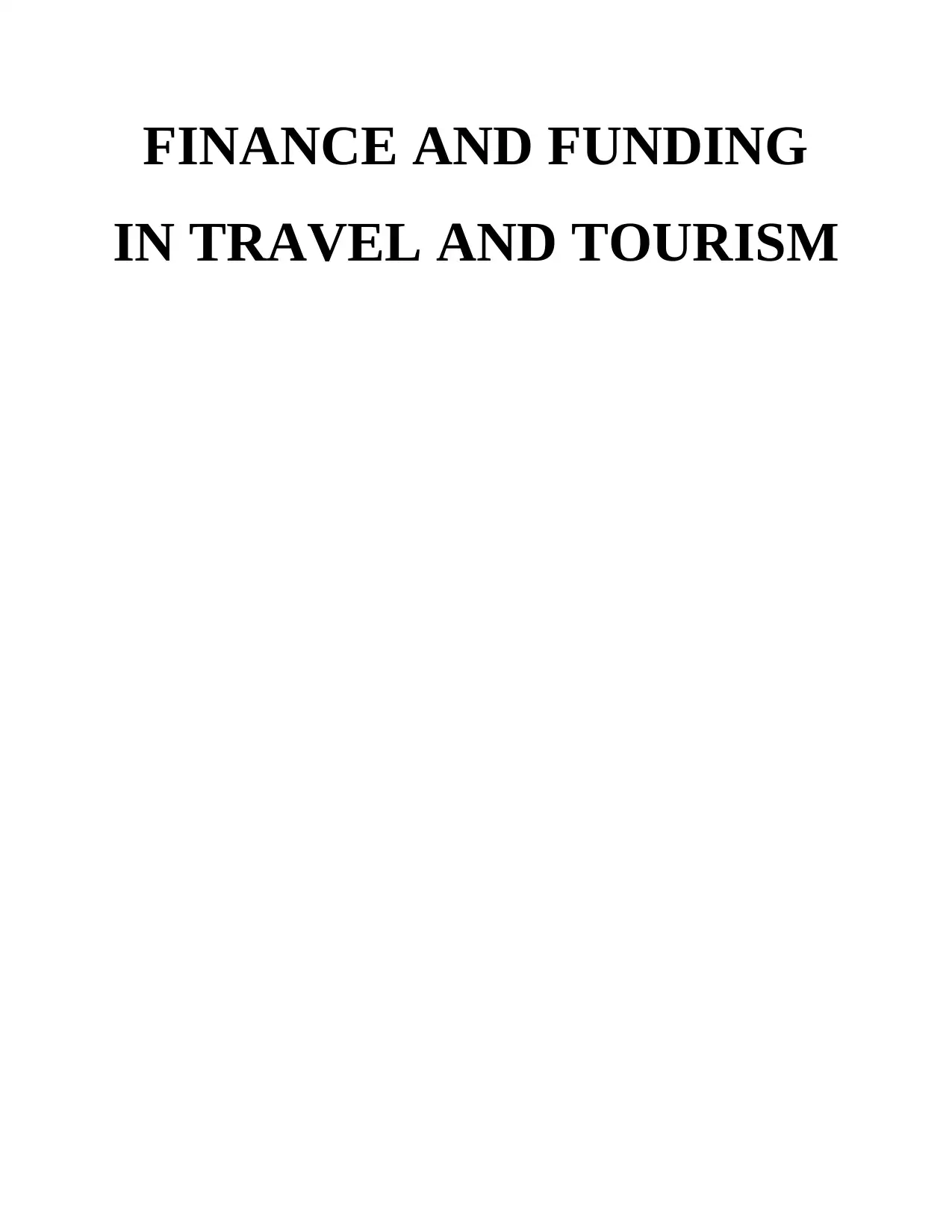
FINANCE AND FUNDING
IN TRAVEL AND TOURISM
IN TRAVEL AND TOURISM
Secure Best Marks with AI Grader
Need help grading? Try our AI Grader for instant feedback on your assignments.
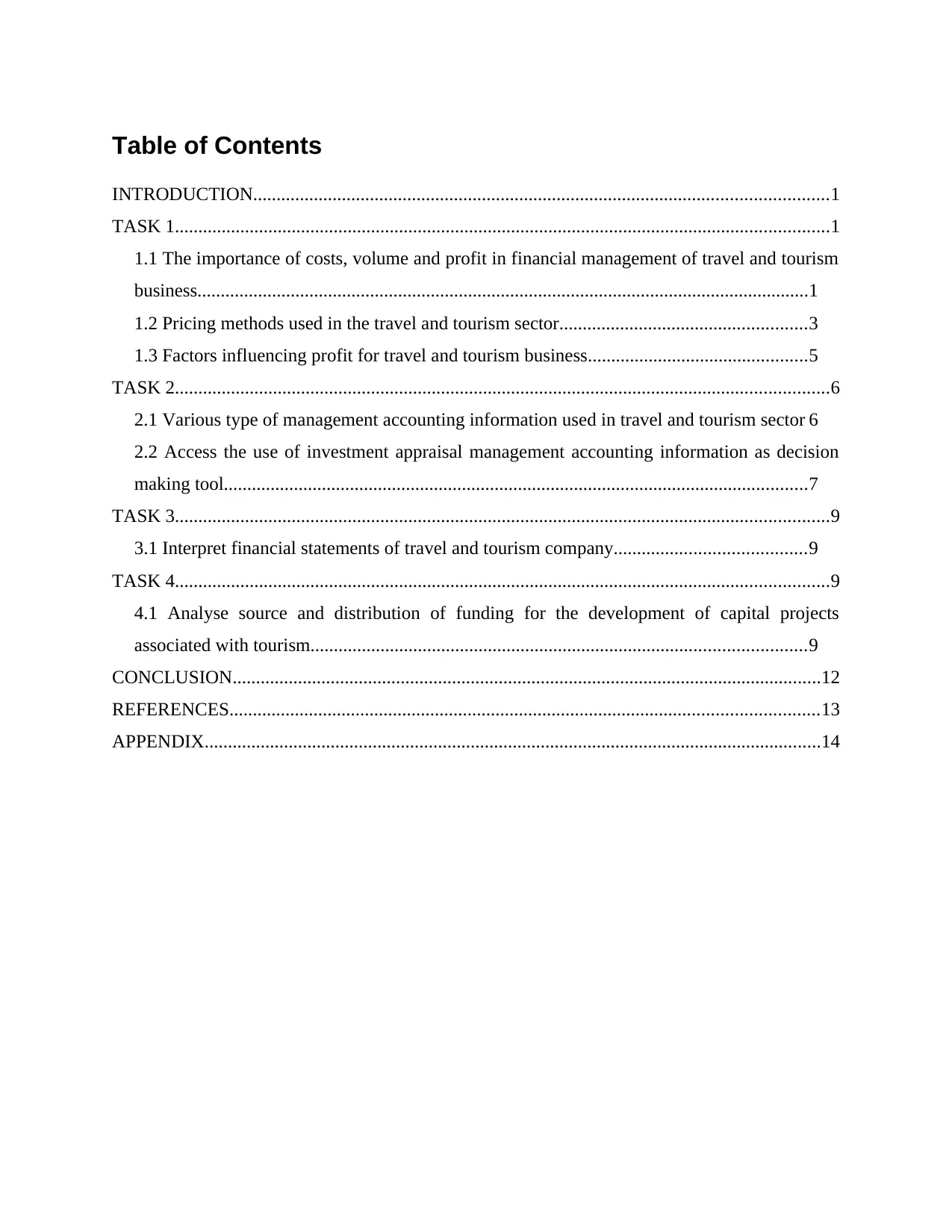
Table of Contents
INTRODUCTION...........................................................................................................................1
TASK 1............................................................................................................................................1
1.1 The importance of costs, volume and profit in financial management of travel and tourism
business...................................................................................................................................1
1.2 Pricing methods used in the travel and tourism sector.....................................................3
1.3 Factors influencing profit for travel and tourism business...............................................5
TASK 2............................................................................................................................................6
2.1 Various type of management accounting information used in travel and tourism sector 6
2.2 Access the use of investment appraisal management accounting information as decision
making tool.............................................................................................................................7
TASK 3............................................................................................................................................9
3.1 Interpret financial statements of travel and tourism company.........................................9
TASK 4............................................................................................................................................9
4.1 Analyse source and distribution of funding for the development of capital projects
associated with tourism..........................................................................................................9
CONCLUSION..............................................................................................................................12
REFERENCES..............................................................................................................................13
APPENDIX....................................................................................................................................14
INTRODUCTION...........................................................................................................................1
TASK 1............................................................................................................................................1
1.1 The importance of costs, volume and profit in financial management of travel and tourism
business...................................................................................................................................1
1.2 Pricing methods used in the travel and tourism sector.....................................................3
1.3 Factors influencing profit for travel and tourism business...............................................5
TASK 2............................................................................................................................................6
2.1 Various type of management accounting information used in travel and tourism sector 6
2.2 Access the use of investment appraisal management accounting information as decision
making tool.............................................................................................................................7
TASK 3............................................................................................................................................9
3.1 Interpret financial statements of travel and tourism company.........................................9
TASK 4............................................................................................................................................9
4.1 Analyse source and distribution of funding for the development of capital projects
associated with tourism..........................................................................................................9
CONCLUSION..............................................................................................................................12
REFERENCES..............................................................................................................................13
APPENDIX....................................................................................................................................14
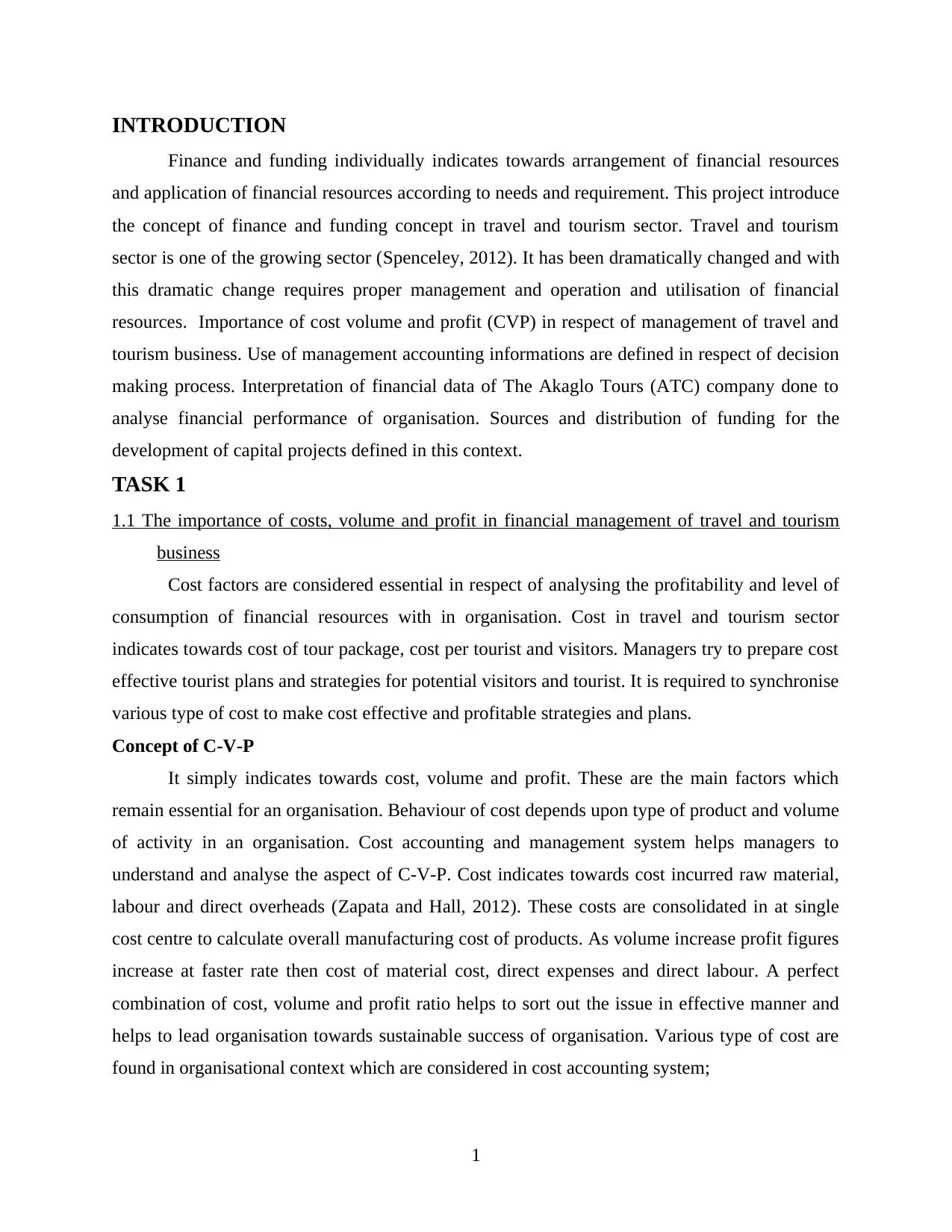
INTRODUCTION
Finance and funding individually indicates towards arrangement of financial resources
and application of financial resources according to needs and requirement. This project introduce
the concept of finance and funding concept in travel and tourism sector. Travel and tourism
sector is one of the growing sector (Spenceley, 2012). It has been dramatically changed and with
this dramatic change requires proper management and operation and utilisation of financial
resources. Importance of cost volume and profit (CVP) in respect of management of travel and
tourism business. Use of management accounting informations are defined in respect of decision
making process. Interpretation of financial data of The Akaglo Tours (ATC) company done to
analyse financial performance of organisation. Sources and distribution of funding for the
development of capital projects defined in this context.
TASK 1
1.1 The importance of costs, volume and profit in financial management of travel and tourism
business
Cost factors are considered essential in respect of analysing the profitability and level of
consumption of financial resources with in organisation. Cost in travel and tourism sector
indicates towards cost of tour package, cost per tourist and visitors. Managers try to prepare cost
effective tourist plans and strategies for potential visitors and tourist. It is required to synchronise
various type of cost to make cost effective and profitable strategies and plans.
Concept of C-V-P
It simply indicates towards cost, volume and profit. These are the main factors which
remain essential for an organisation. Behaviour of cost depends upon type of product and volume
of activity in an organisation. Cost accounting and management system helps managers to
understand and analyse the aspect of C-V-P. Cost indicates towards cost incurred raw material,
labour and direct overheads (Zapata and Hall, 2012). These costs are consolidated in at single
cost centre to calculate overall manufacturing cost of products. As volume increase profit figures
increase at faster rate then cost of material cost, direct expenses and direct labour. A perfect
combination of cost, volume and profit ratio helps to sort out the issue in effective manner and
helps to lead organisation towards sustainable success of organisation. Various type of cost are
found in organisational context which are considered in cost accounting system;
1
Finance and funding individually indicates towards arrangement of financial resources
and application of financial resources according to needs and requirement. This project introduce
the concept of finance and funding concept in travel and tourism sector. Travel and tourism
sector is one of the growing sector (Spenceley, 2012). It has been dramatically changed and with
this dramatic change requires proper management and operation and utilisation of financial
resources. Importance of cost volume and profit (CVP) in respect of management of travel and
tourism business. Use of management accounting informations are defined in respect of decision
making process. Interpretation of financial data of The Akaglo Tours (ATC) company done to
analyse financial performance of organisation. Sources and distribution of funding for the
development of capital projects defined in this context.
TASK 1
1.1 The importance of costs, volume and profit in financial management of travel and tourism
business
Cost factors are considered essential in respect of analysing the profitability and level of
consumption of financial resources with in organisation. Cost in travel and tourism sector
indicates towards cost of tour package, cost per tourist and visitors. Managers try to prepare cost
effective tourist plans and strategies for potential visitors and tourist. It is required to synchronise
various type of cost to make cost effective and profitable strategies and plans.
Concept of C-V-P
It simply indicates towards cost, volume and profit. These are the main factors which
remain essential for an organisation. Behaviour of cost depends upon type of product and volume
of activity in an organisation. Cost accounting and management system helps managers to
understand and analyse the aspect of C-V-P. Cost indicates towards cost incurred raw material,
labour and direct overheads (Zapata and Hall, 2012). These costs are consolidated in at single
cost centre to calculate overall manufacturing cost of products. As volume increase profit figures
increase at faster rate then cost of material cost, direct expenses and direct labour. A perfect
combination of cost, volume and profit ratio helps to sort out the issue in effective manner and
helps to lead organisation towards sustainable success of organisation. Various type of cost are
found in organisational context which are considered in cost accounting system;
1
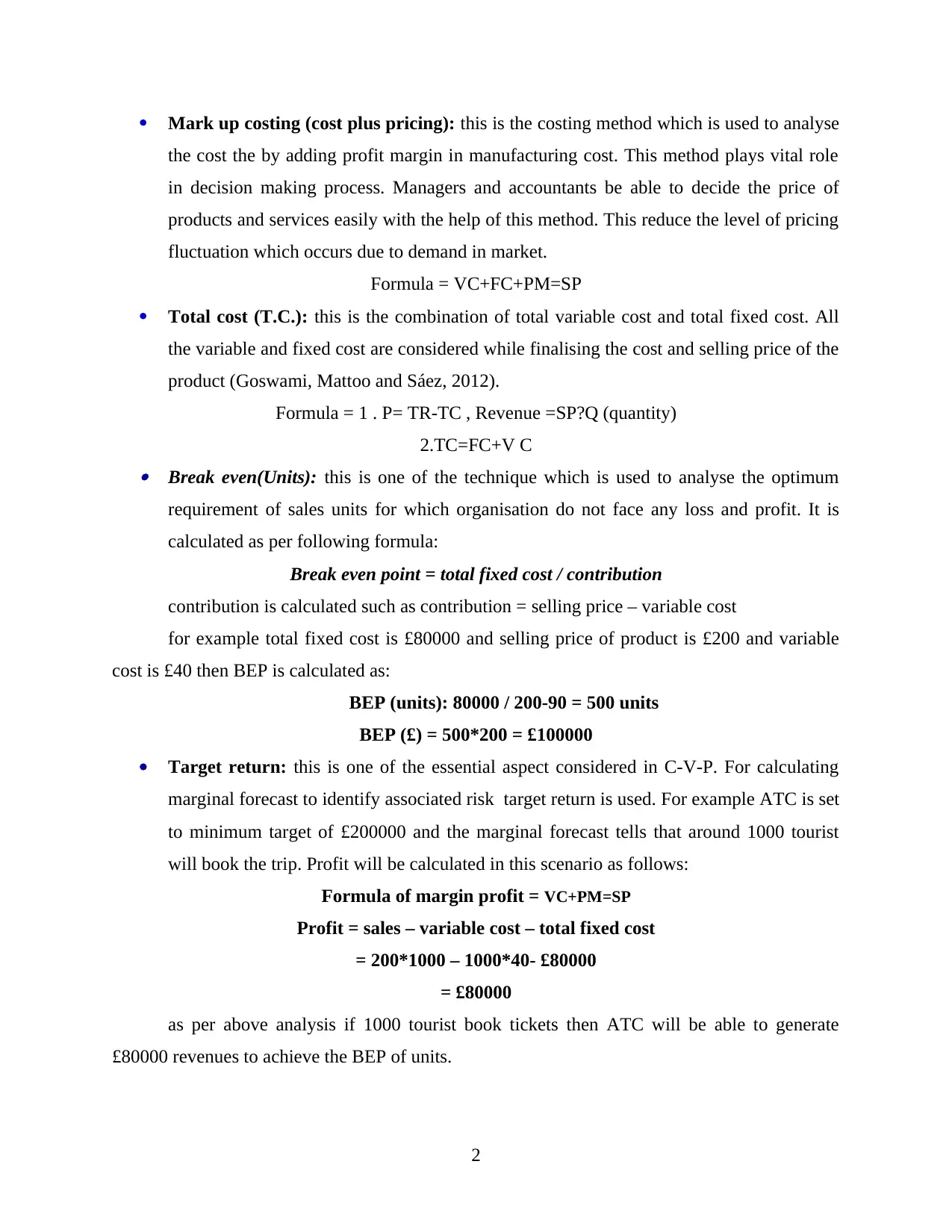
Mark up costing (cost plus pricing): this is the costing method which is used to analyse
the cost the by adding profit margin in manufacturing cost. This method plays vital role
in decision making process. Managers and accountants be able to decide the price of
products and services easily with the help of this method. This reduce the level of pricing
fluctuation which occurs due to demand in market.
Formula = VC+FC+PM=SP
Total cost (T.C.): this is the combination of total variable cost and total fixed cost. All
the variable and fixed cost are considered while finalising the cost and selling price of the
product (Goswami, Mattoo and Sáez, 2012).
Formula = 1 . P= TR-TC , Revenue =SP?Q (quantity)
2.TC=FC+V C Break even(Units): this is one of the technique which is used to analyse the optimum
requirement of sales units for which organisation do not face any loss and profit. It is
calculated as per following formula:
Break even point = total fixed cost / contribution
contribution is calculated such as contribution = selling price – variable cost
for example total fixed cost is £80000 and selling price of product is £200 and variable
cost is £40 then BEP is calculated as:
BEP (units): 80000 / 200-90 = 500 units
BEP (£) = 500*200 = £100000
Target return: this is one of the essential aspect considered in C-V-P. For calculating
marginal forecast to identify associated risk target return is used. For example ATC is set
to minimum target of £200000 and the marginal forecast tells that around 1000 tourist
will book the trip. Profit will be calculated in this scenario as follows:
Formula of margin profit = VC+PM=SP
Profit = sales – variable cost – total fixed cost
= 200*1000 – 1000*40- £80000
= £80000
as per above analysis if 1000 tourist book tickets then ATC will be able to generate
£80000 revenues to achieve the BEP of units.
2
the cost the by adding profit margin in manufacturing cost. This method plays vital role
in decision making process. Managers and accountants be able to decide the price of
products and services easily with the help of this method. This reduce the level of pricing
fluctuation which occurs due to demand in market.
Formula = VC+FC+PM=SP
Total cost (T.C.): this is the combination of total variable cost and total fixed cost. All
the variable and fixed cost are considered while finalising the cost and selling price of the
product (Goswami, Mattoo and Sáez, 2012).
Formula = 1 . P= TR-TC , Revenue =SP?Q (quantity)
2.TC=FC+V C Break even(Units): this is one of the technique which is used to analyse the optimum
requirement of sales units for which organisation do not face any loss and profit. It is
calculated as per following formula:
Break even point = total fixed cost / contribution
contribution is calculated such as contribution = selling price – variable cost
for example total fixed cost is £80000 and selling price of product is £200 and variable
cost is £40 then BEP is calculated as:
BEP (units): 80000 / 200-90 = 500 units
BEP (£) = 500*200 = £100000
Target return: this is one of the essential aspect considered in C-V-P. For calculating
marginal forecast to identify associated risk target return is used. For example ATC is set
to minimum target of £200000 and the marginal forecast tells that around 1000 tourist
will book the trip. Profit will be calculated in this scenario as follows:
Formula of margin profit = VC+PM=SP
Profit = sales – variable cost – total fixed cost
= 200*1000 – 1000*40- £80000
= £80000
as per above analysis if 1000 tourist book tickets then ATC will be able to generate
£80000 revenues to achieve the BEP of units.
2
Secure Best Marks with AI Grader
Need help grading? Try our AI Grader for instant feedback on your assignments.
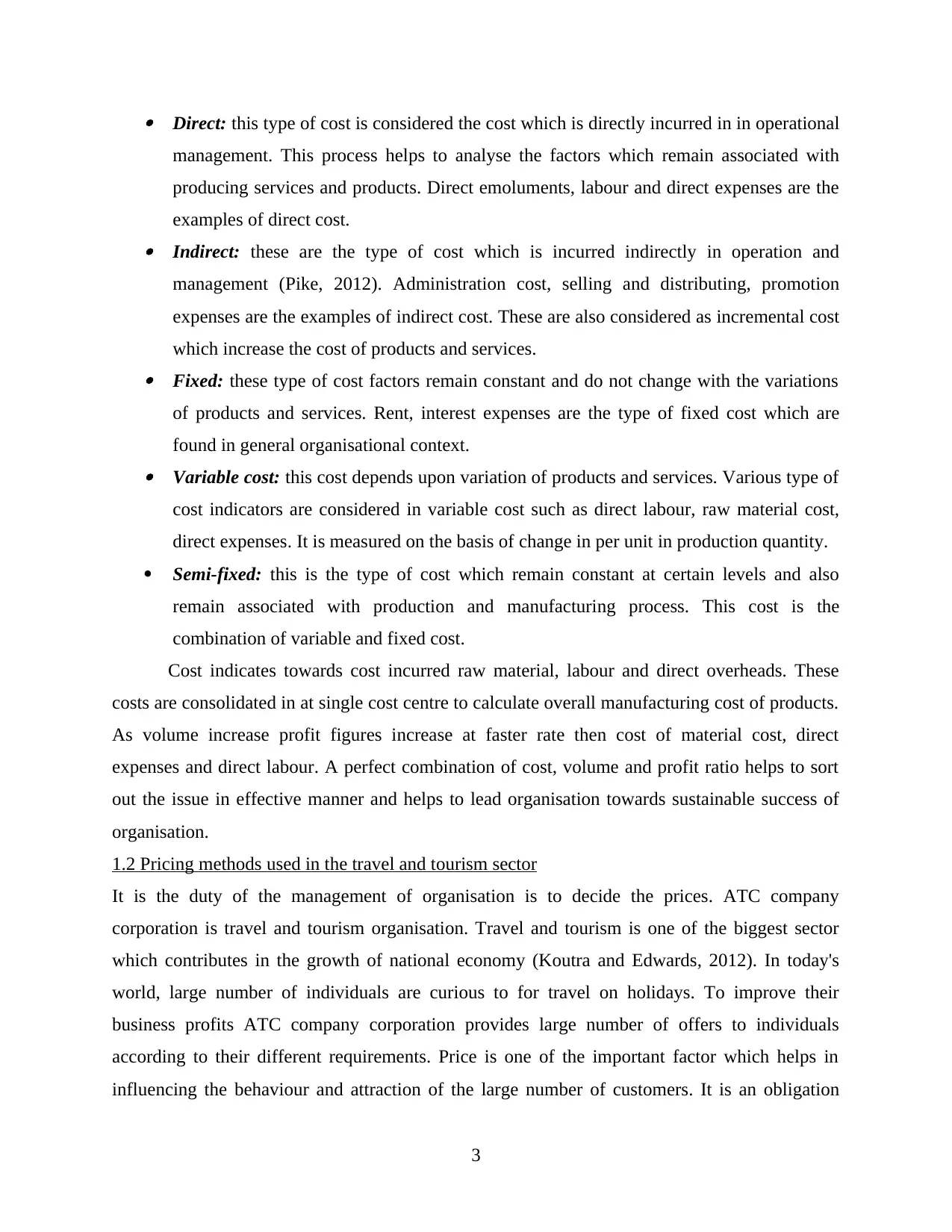
Direct: this type of cost is considered the cost which is directly incurred in in operational
management. This process helps to analyse the factors which remain associated with
producing services and products. Direct emoluments, labour and direct expenses are the
examples of direct cost. Indirect: these are the type of cost which is incurred indirectly in operation and
management (Pike, 2012). Administration cost, selling and distributing, promotion
expenses are the examples of indirect cost. These are also considered as incremental cost
which increase the cost of products and services. Fixed: these type of cost factors remain constant and do not change with the variations
of products and services. Rent, interest expenses are the type of fixed cost which are
found in general organisational context. Variable cost: this cost depends upon variation of products and services. Various type of
cost indicators are considered in variable cost such as direct labour, raw material cost,
direct expenses. It is measured on the basis of change in per unit in production quantity.
Semi-fixed: this is the type of cost which remain constant at certain levels and also
remain associated with production and manufacturing process. This cost is the
combination of variable and fixed cost.
Cost indicates towards cost incurred raw material, labour and direct overheads. These
costs are consolidated in at single cost centre to calculate overall manufacturing cost of products.
As volume increase profit figures increase at faster rate then cost of material cost, direct
expenses and direct labour. A perfect combination of cost, volume and profit ratio helps to sort
out the issue in effective manner and helps to lead organisation towards sustainable success of
organisation.
1.2 Pricing methods used in the travel and tourism sector
It is the duty of the management of organisation is to decide the prices. ATC company
corporation is travel and tourism organisation. Travel and tourism is one of the biggest sector
which contributes in the growth of national economy (Koutra and Edwards, 2012). In today's
world, large number of individuals are curious to for travel on holidays. To improve their
business profits ATC company corporation provides large number of offers to individuals
according to their different requirements. Price is one of the important factor which helps in
influencing the behaviour and attraction of the large number of customers. It is an obligation
3
management. This process helps to analyse the factors which remain associated with
producing services and products. Direct emoluments, labour and direct expenses are the
examples of direct cost. Indirect: these are the type of cost which is incurred indirectly in operation and
management (Pike, 2012). Administration cost, selling and distributing, promotion
expenses are the examples of indirect cost. These are also considered as incremental cost
which increase the cost of products and services. Fixed: these type of cost factors remain constant and do not change with the variations
of products and services. Rent, interest expenses are the type of fixed cost which are
found in general organisational context. Variable cost: this cost depends upon variation of products and services. Various type of
cost indicators are considered in variable cost such as direct labour, raw material cost,
direct expenses. It is measured on the basis of change in per unit in production quantity.
Semi-fixed: this is the type of cost which remain constant at certain levels and also
remain associated with production and manufacturing process. This cost is the
combination of variable and fixed cost.
Cost indicates towards cost incurred raw material, labour and direct overheads. These
costs are consolidated in at single cost centre to calculate overall manufacturing cost of products.
As volume increase profit figures increase at faster rate then cost of material cost, direct
expenses and direct labour. A perfect combination of cost, volume and profit ratio helps to sort
out the issue in effective manner and helps to lead organisation towards sustainable success of
organisation.
1.2 Pricing methods used in the travel and tourism sector
It is the duty of the management of organisation is to decide the prices. ATC company
corporation is travel and tourism organisation. Travel and tourism is one of the biggest sector
which contributes in the growth of national economy (Koutra and Edwards, 2012). In today's
world, large number of individuals are curious to for travel on holidays. To improve their
business profits ATC company corporation provides large number of offers to individuals
according to their different requirements. Price is one of the important factor which helps in
influencing the behaviour and attraction of the large number of customers. It is an obligation
3
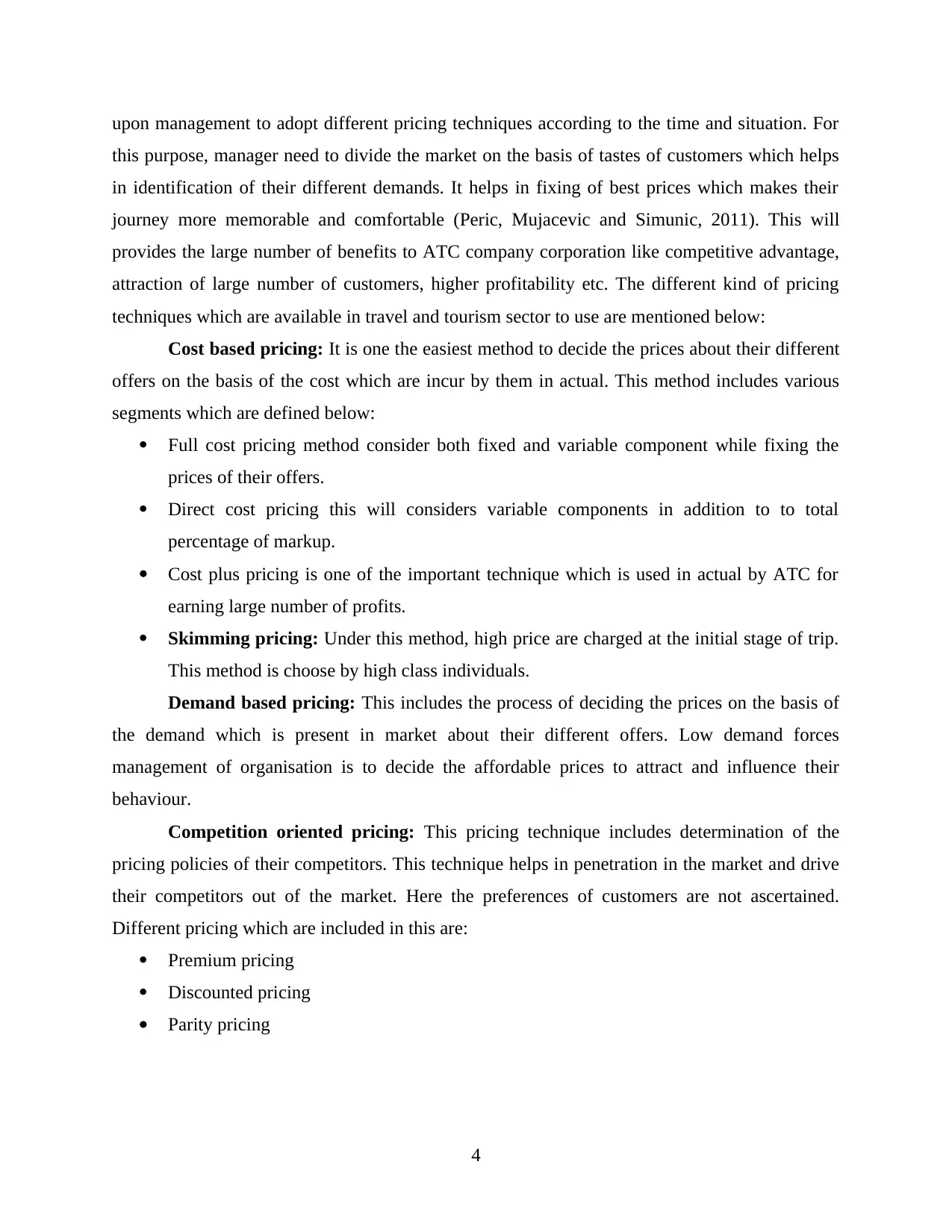
upon management to adopt different pricing techniques according to the time and situation. For
this purpose, manager need to divide the market on the basis of tastes of customers which helps
in identification of their different demands. It helps in fixing of best prices which makes their
journey more memorable and comfortable (Peric, Mujacevic and Simunic, 2011). This will
provides the large number of benefits to ATC company corporation like competitive advantage,
attraction of large number of customers, higher profitability etc. The different kind of pricing
techniques which are available in travel and tourism sector to use are mentioned below:
Cost based pricing: It is one the easiest method to decide the prices about their different
offers on the basis of the cost which are incur by them in actual. This method includes various
segments which are defined below:
Full cost pricing method consider both fixed and variable component while fixing the
prices of their offers.
Direct cost pricing this will considers variable components in addition to to total
percentage of markup.
Cost plus pricing is one of the important technique which is used in actual by ATC for
earning large number of profits.
Skimming pricing: Under this method, high price are charged at the initial stage of trip.
This method is choose by high class individuals.
Demand based pricing: This includes the process of deciding the prices on the basis of
the demand which is present in market about their different offers. Low demand forces
management of organisation is to decide the affordable prices to attract and influence their
behaviour.
Competition oriented pricing: This pricing technique includes determination of the
pricing policies of their competitors. This technique helps in penetration in the market and drive
their competitors out of the market. Here the preferences of customers are not ascertained.
Different pricing which are included in this are:
Premium pricing
Discounted pricing
Parity pricing
4
this purpose, manager need to divide the market on the basis of tastes of customers which helps
in identification of their different demands. It helps in fixing of best prices which makes their
journey more memorable and comfortable (Peric, Mujacevic and Simunic, 2011). This will
provides the large number of benefits to ATC company corporation like competitive advantage,
attraction of large number of customers, higher profitability etc. The different kind of pricing
techniques which are available in travel and tourism sector to use are mentioned below:
Cost based pricing: It is one the easiest method to decide the prices about their different
offers on the basis of the cost which are incur by them in actual. This method includes various
segments which are defined below:
Full cost pricing method consider both fixed and variable component while fixing the
prices of their offers.
Direct cost pricing this will considers variable components in addition to to total
percentage of markup.
Cost plus pricing is one of the important technique which is used in actual by ATC for
earning large number of profits.
Skimming pricing: Under this method, high price are charged at the initial stage of trip.
This method is choose by high class individuals.
Demand based pricing: This includes the process of deciding the prices on the basis of
the demand which is present in market about their different offers. Low demand forces
management of organisation is to decide the affordable prices to attract and influence their
behaviour.
Competition oriented pricing: This pricing technique includes determination of the
pricing policies of their competitors. This technique helps in penetration in the market and drive
their competitors out of the market. Here the preferences of customers are not ascertained.
Different pricing which are included in this are:
Premium pricing
Discounted pricing
Parity pricing
4
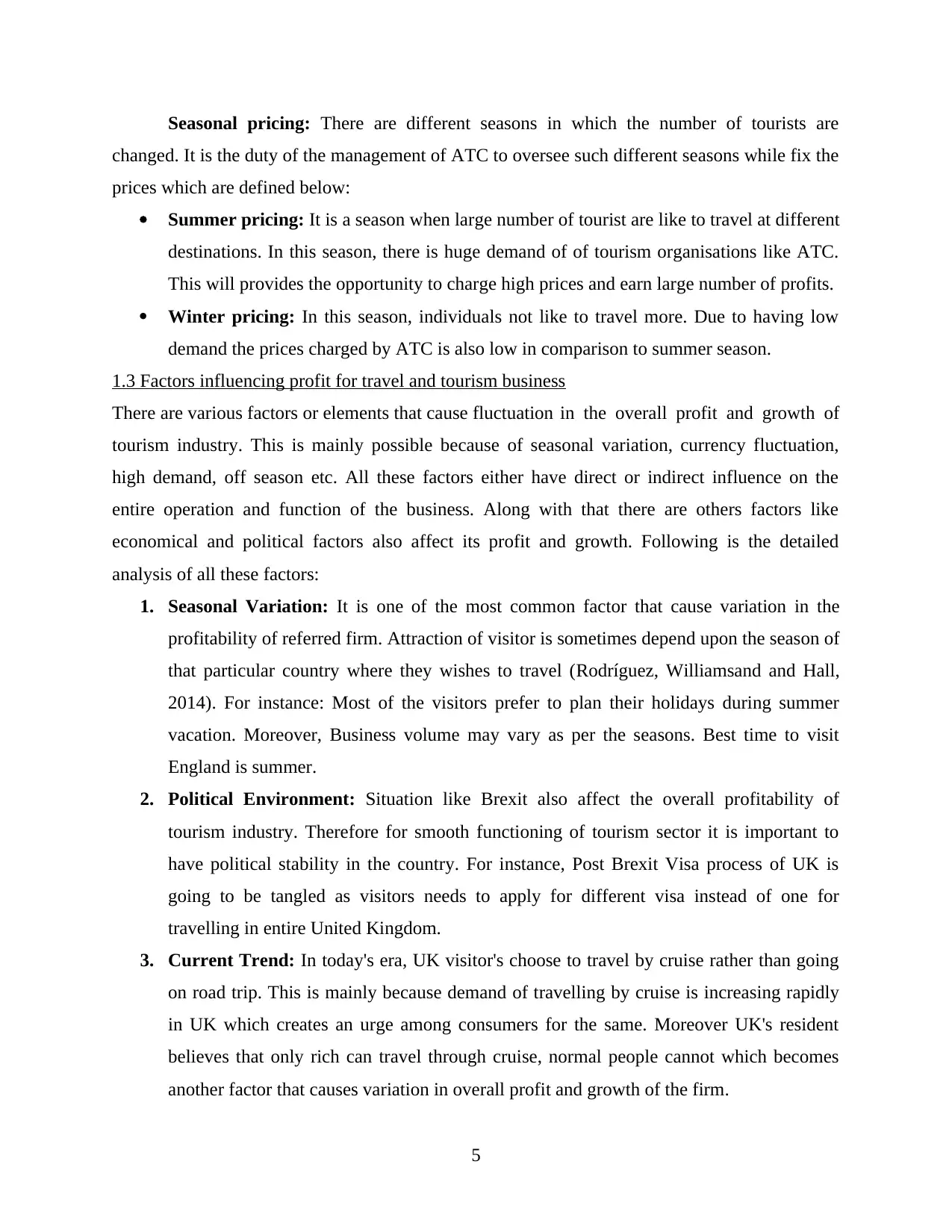
Seasonal pricing: There are different seasons in which the number of tourists are
changed. It is the duty of the management of ATC to oversee such different seasons while fix the
prices which are defined below:
Summer pricing: It is a season when large number of tourist are like to travel at different
destinations. In this season, there is huge demand of of tourism organisations like ATC.
This will provides the opportunity to charge high prices and earn large number of profits.
Winter pricing: In this season, individuals not like to travel more. Due to having low
demand the prices charged by ATC is also low in comparison to summer season.
1.3 Factors influencing profit for travel and tourism business
There are various factors or elements that cause fluctuation in the overall profit and growth of
tourism industry. This is mainly possible because of seasonal variation, currency fluctuation,
high demand, off season etc. All these factors either have direct or indirect influence on the
entire operation and function of the business. Along with that there are others factors like
economical and political factors also affect its profit and growth. Following is the detailed
analysis of all these factors:
1. Seasonal Variation: It is one of the most common factor that cause variation in the
profitability of referred firm. Attraction of visitor is sometimes depend upon the season of
that particular country where they wishes to travel (Rodríguez, Williamsand and Hall,
2014). For instance: Most of the visitors prefer to plan their holidays during summer
vacation. Moreover, Business volume may vary as per the seasons. Best time to visit
England is summer.
2. Political Environment: Situation like Brexit also affect the overall profitability of
tourism industry. Therefore for smooth functioning of tourism sector it is important to
have political stability in the country. For instance, Post Brexit Visa process of UK is
going to be tangled as visitors needs to apply for different visa instead of one for
travelling in entire United Kingdom.
3. Current Trend: In today's era, UK visitor's choose to travel by cruise rather than going
on road trip. This is mainly because demand of travelling by cruise is increasing rapidly
in UK which creates an urge among consumers for the same. Moreover UK's resident
believes that only rich can travel through cruise, normal people cannot which becomes
another factor that causes variation in overall profit and growth of the firm.
5
changed. It is the duty of the management of ATC to oversee such different seasons while fix the
prices which are defined below:
Summer pricing: It is a season when large number of tourist are like to travel at different
destinations. In this season, there is huge demand of of tourism organisations like ATC.
This will provides the opportunity to charge high prices and earn large number of profits.
Winter pricing: In this season, individuals not like to travel more. Due to having low
demand the prices charged by ATC is also low in comparison to summer season.
1.3 Factors influencing profit for travel and tourism business
There are various factors or elements that cause fluctuation in the overall profit and growth of
tourism industry. This is mainly possible because of seasonal variation, currency fluctuation,
high demand, off season etc. All these factors either have direct or indirect influence on the
entire operation and function of the business. Along with that there are others factors like
economical and political factors also affect its profit and growth. Following is the detailed
analysis of all these factors:
1. Seasonal Variation: It is one of the most common factor that cause variation in the
profitability of referred firm. Attraction of visitor is sometimes depend upon the season of
that particular country where they wishes to travel (Rodríguez, Williamsand and Hall,
2014). For instance: Most of the visitors prefer to plan their holidays during summer
vacation. Moreover, Business volume may vary as per the seasons. Best time to visit
England is summer.
2. Political Environment: Situation like Brexit also affect the overall profitability of
tourism industry. Therefore for smooth functioning of tourism sector it is important to
have political stability in the country. For instance, Post Brexit Visa process of UK is
going to be tangled as visitors needs to apply for different visa instead of one for
travelling in entire United Kingdom.
3. Current Trend: In today's era, UK visitor's choose to travel by cruise rather than going
on road trip. This is mainly because demand of travelling by cruise is increasing rapidly
in UK which creates an urge among consumers for the same. Moreover UK's resident
believes that only rich can travel through cruise, normal people cannot which becomes
another factor that causes variation in overall profit and growth of the firm.
5
Paraphrase This Document
Need a fresh take? Get an instant paraphrase of this document with our AI Paraphraser
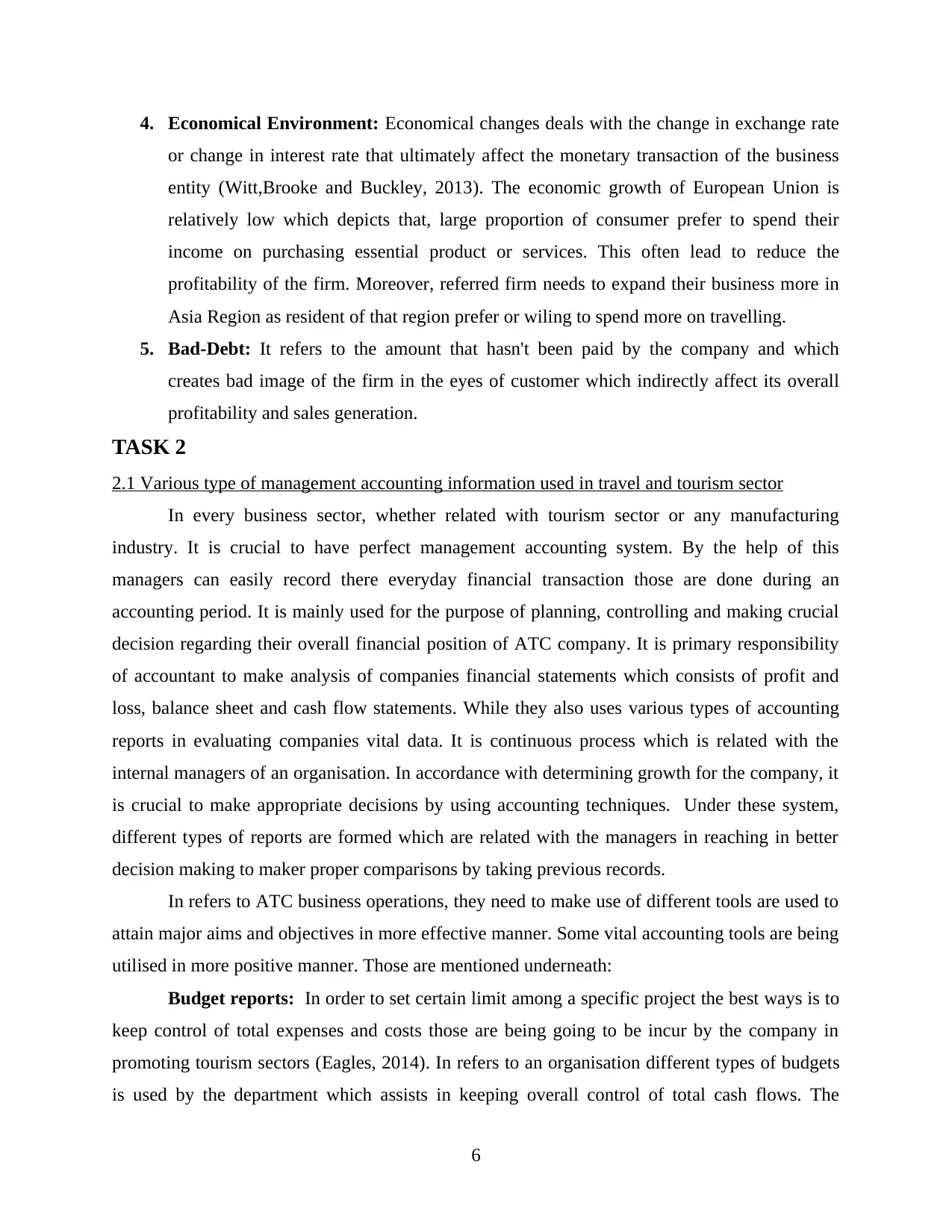
4. Economical Environment: Economical changes deals with the change in exchange rate
or change in interest rate that ultimately affect the monetary transaction of the business
entity (Witt,Brooke and Buckley, 2013). The economic growth of European Union is
relatively low which depicts that, large proportion of consumer prefer to spend their
income on purchasing essential product or services. This often lead to reduce the
profitability of the firm. Moreover, referred firm needs to expand their business more in
Asia Region as resident of that region prefer or wiling to spend more on travelling.
5. Bad-Debt: It refers to the amount that hasn't been paid by the company and which
creates bad image of the firm in the eyes of customer which indirectly affect its overall
profitability and sales generation.
TASK 2
2.1 Various type of management accounting information used in travel and tourism sector
In every business sector, whether related with tourism sector or any manufacturing
industry. It is crucial to have perfect management accounting system. By the help of this
managers can easily record there everyday financial transaction those are done during an
accounting period. It is mainly used for the purpose of planning, controlling and making crucial
decision regarding their overall financial position of ATC company. It is primary responsibility
of accountant to make analysis of companies financial statements which consists of profit and
loss, balance sheet and cash flow statements. While they also uses various types of accounting
reports in evaluating companies vital data. It is continuous process which is related with the
internal managers of an organisation. In accordance with determining growth for the company, it
is crucial to make appropriate decisions by using accounting techniques. Under these system,
different types of reports are formed which are related with the managers in reaching in better
decision making to maker proper comparisons by taking previous records.
In refers to ATC business operations, they need to make use of different tools are used to
attain major aims and objectives in more effective manner. Some vital accounting tools are being
utilised in more positive manner. Those are mentioned underneath:
Budget reports: In order to set certain limit among a specific project the best ways is to
keep control of total expenses and costs those are being going to be incur by the company in
promoting tourism sectors (Eagles, 2014). In refers to an organisation different types of budgets
is used by the department which assists in keeping overall control of total cash flows. The
6
or change in interest rate that ultimately affect the monetary transaction of the business
entity (Witt,Brooke and Buckley, 2013). The economic growth of European Union is
relatively low which depicts that, large proportion of consumer prefer to spend their
income on purchasing essential product or services. This often lead to reduce the
profitability of the firm. Moreover, referred firm needs to expand their business more in
Asia Region as resident of that region prefer or wiling to spend more on travelling.
5. Bad-Debt: It refers to the amount that hasn't been paid by the company and which
creates bad image of the firm in the eyes of customer which indirectly affect its overall
profitability and sales generation.
TASK 2
2.1 Various type of management accounting information used in travel and tourism sector
In every business sector, whether related with tourism sector or any manufacturing
industry. It is crucial to have perfect management accounting system. By the help of this
managers can easily record there everyday financial transaction those are done during an
accounting period. It is mainly used for the purpose of planning, controlling and making crucial
decision regarding their overall financial position of ATC company. It is primary responsibility
of accountant to make analysis of companies financial statements which consists of profit and
loss, balance sheet and cash flow statements. While they also uses various types of accounting
reports in evaluating companies vital data. It is continuous process which is related with the
internal managers of an organisation. In accordance with determining growth for the company, it
is crucial to make appropriate decisions by using accounting techniques. Under these system,
different types of reports are formed which are related with the managers in reaching in better
decision making to maker proper comparisons by taking previous records.
In refers to ATC business operations, they need to make use of different tools are used to
attain major aims and objectives in more effective manner. Some vital accounting tools are being
utilised in more positive manner. Those are mentioned underneath:
Budget reports: In order to set certain limit among a specific project the best ways is to
keep control of total expenses and costs those are being going to be incur by the company in
promoting tourism sectors (Eagles, 2014). In refers to an organisation different types of budgets
is used by the department which assists in keeping overall control of total cash flows. The
6
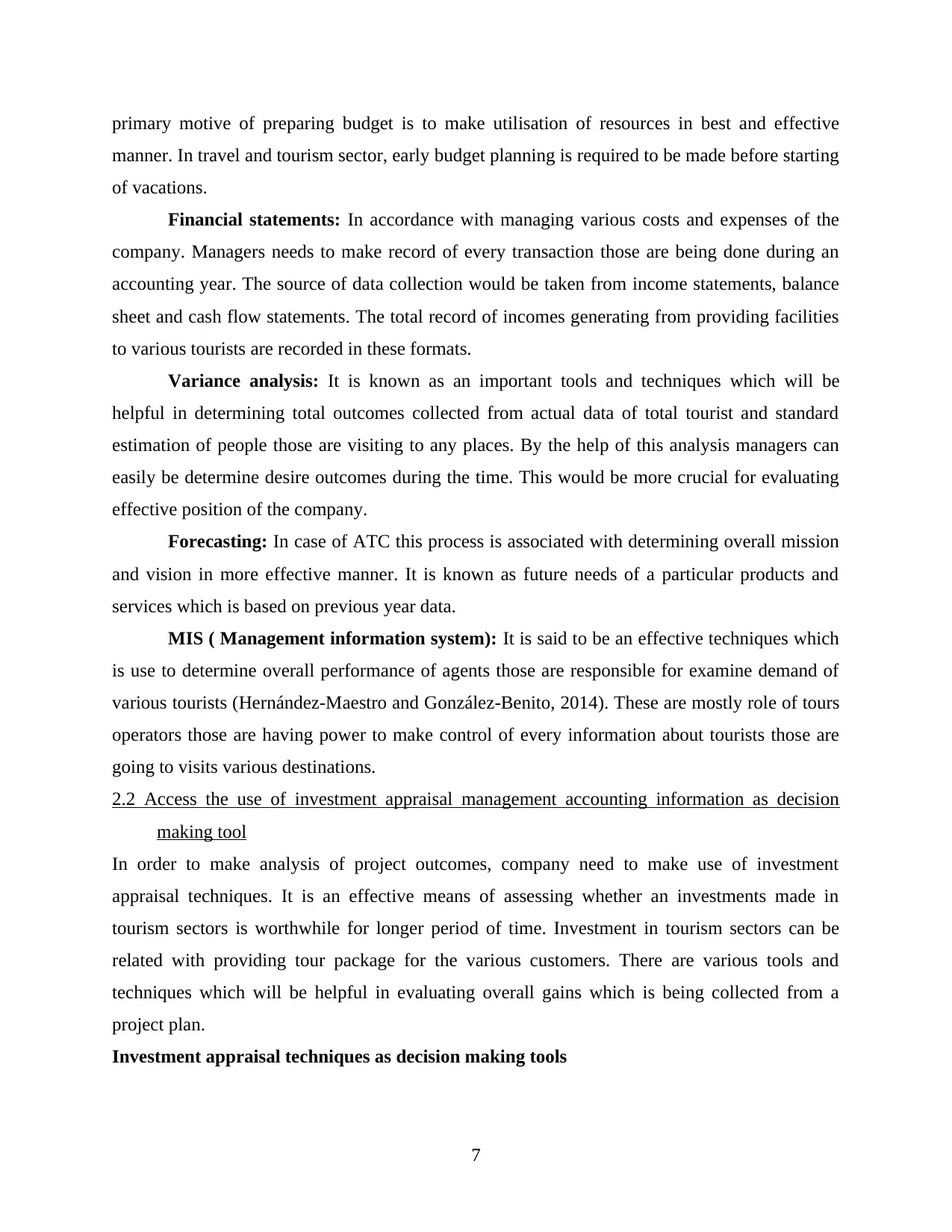
primary motive of preparing budget is to make utilisation of resources in best and effective
manner. In travel and tourism sector, early budget planning is required to be made before starting
of vacations.
Financial statements: In accordance with managing various costs and expenses of the
company. Managers needs to make record of every transaction those are being done during an
accounting year. The source of data collection would be taken from income statements, balance
sheet and cash flow statements. The total record of incomes generating from providing facilities
to various tourists are recorded in these formats.
Variance analysis: It is known as an important tools and techniques which will be
helpful in determining total outcomes collected from actual data of total tourist and standard
estimation of people those are visiting to any places. By the help of this analysis managers can
easily be determine desire outcomes during the time. This would be more crucial for evaluating
effective position of the company.
Forecasting: In case of ATC this process is associated with determining overall mission
and vision in more effective manner. It is known as future needs of a particular products and
services which is based on previous year data.
MIS ( Management information system): It is said to be an effective techniques which
is use to determine overall performance of agents those are responsible for examine demand of
various tourists (Hernández-Maestro and González-Benito, 2014). These are mostly role of tours
operators those are having power to make control of every information about tourists those are
going to visits various destinations.
2.2 Access the use of investment appraisal management accounting information as decision
making tool
In order to make analysis of project outcomes, company need to make use of investment
appraisal techniques. It is an effective means of assessing whether an investments made in
tourism sectors is worthwhile for longer period of time. Investment in tourism sectors can be
related with providing tour package for the various customers. There are various tools and
techniques which will be helpful in evaluating overall gains which is being collected from a
project plan.
Investment appraisal techniques as decision making tools
7
manner. In travel and tourism sector, early budget planning is required to be made before starting
of vacations.
Financial statements: In accordance with managing various costs and expenses of the
company. Managers needs to make record of every transaction those are being done during an
accounting year. The source of data collection would be taken from income statements, balance
sheet and cash flow statements. The total record of incomes generating from providing facilities
to various tourists are recorded in these formats.
Variance analysis: It is known as an important tools and techniques which will be
helpful in determining total outcomes collected from actual data of total tourist and standard
estimation of people those are visiting to any places. By the help of this analysis managers can
easily be determine desire outcomes during the time. This would be more crucial for evaluating
effective position of the company.
Forecasting: In case of ATC this process is associated with determining overall mission
and vision in more effective manner. It is known as future needs of a particular products and
services which is based on previous year data.
MIS ( Management information system): It is said to be an effective techniques which
is use to determine overall performance of agents those are responsible for examine demand of
various tourists (Hernández-Maestro and González-Benito, 2014). These are mostly role of tours
operators those are having power to make control of every information about tourists those are
going to visits various destinations.
2.2 Access the use of investment appraisal management accounting information as decision
making tool
In order to make analysis of project outcomes, company need to make use of investment
appraisal techniques. It is an effective means of assessing whether an investments made in
tourism sectors is worthwhile for longer period of time. Investment in tourism sectors can be
related with providing tour package for the various customers. There are various tools and
techniques which will be helpful in evaluating overall gains which is being collected from a
project plan.
Investment appraisal techniques as decision making tools
7
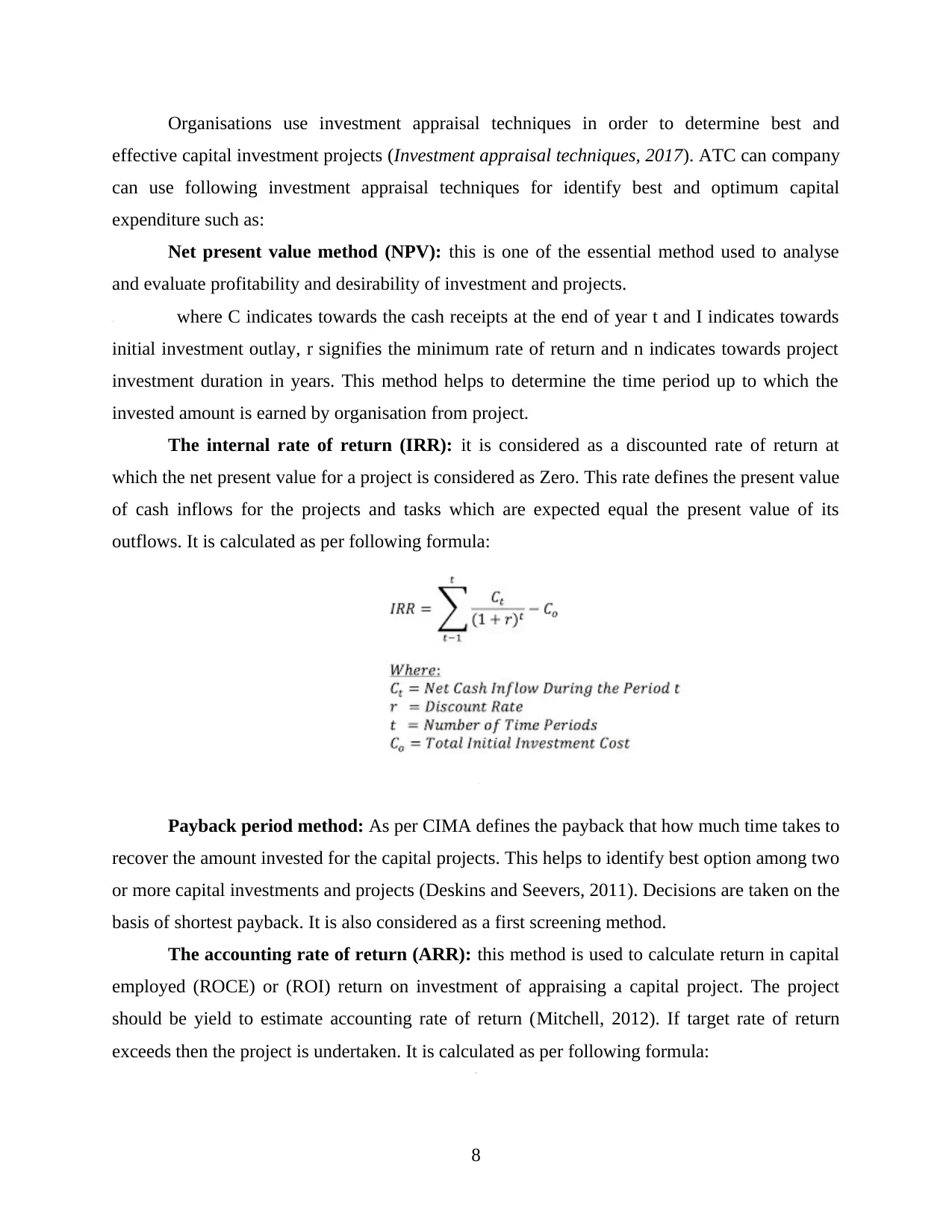
Organisations use investment appraisal techniques in order to determine best and
effective capital investment projects (Investment appraisal techniques, 2017). ATC can company
can use following investment appraisal techniques for identify best and optimum capital
expenditure such as:
Net present value method (NPV): this is one of the essential method used to analyse
and evaluate profitability and desirability of investment and projects.
where C indicates towards the cash receipts at the end of year t and I indicates towards
initial investment outlay, r signifies the minimum rate of return and n indicates towards project
investment duration in years. This method helps to determine the time period up to which the
invested amount is earned by organisation from project.
The internal rate of return (IRR): it is considered as a discounted rate of return at
which the net present value for a project is considered as Zero. This rate defines the present value
of cash inflows for the projects and tasks which are expected equal the present value of its
outflows. It is calculated as per following formula:
Payback period method: As per CIMA defines the payback that how much time takes to
recover the amount invested for the capital projects. This helps to identify best option among two
or more capital investments and projects (Deskins and Seevers, 2011). Decisions are taken on the
basis of shortest payback. It is also considered as a first screening method.
The accounting rate of return (ARR): this method is used to calculate return in capital
employed (ROCE) or (ROI) return on investment of appraising a capital project. The project
should be yield to estimate accounting rate of return (Mitchell, 2012). If target rate of return
exceeds then the project is undertaken. It is calculated as per following formula:
8
effective capital investment projects (Investment appraisal techniques, 2017). ATC can company
can use following investment appraisal techniques for identify best and optimum capital
expenditure such as:
Net present value method (NPV): this is one of the essential method used to analyse
and evaluate profitability and desirability of investment and projects.
where C indicates towards the cash receipts at the end of year t and I indicates towards
initial investment outlay, r signifies the minimum rate of return and n indicates towards project
investment duration in years. This method helps to determine the time period up to which the
invested amount is earned by organisation from project.
The internal rate of return (IRR): it is considered as a discounted rate of return at
which the net present value for a project is considered as Zero. This rate defines the present value
of cash inflows for the projects and tasks which are expected equal the present value of its
outflows. It is calculated as per following formula:
Payback period method: As per CIMA defines the payback that how much time takes to
recover the amount invested for the capital projects. This helps to identify best option among two
or more capital investments and projects (Deskins and Seevers, 2011). Decisions are taken on the
basis of shortest payback. It is also considered as a first screening method.
The accounting rate of return (ARR): this method is used to calculate return in capital
employed (ROCE) or (ROI) return on investment of appraising a capital project. The project
should be yield to estimate accounting rate of return (Mitchell, 2012). If target rate of return
exceeds then the project is undertaken. It is calculated as per following formula:
8
Secure Best Marks with AI Grader
Need help grading? Try our AI Grader for instant feedback on your assignments.
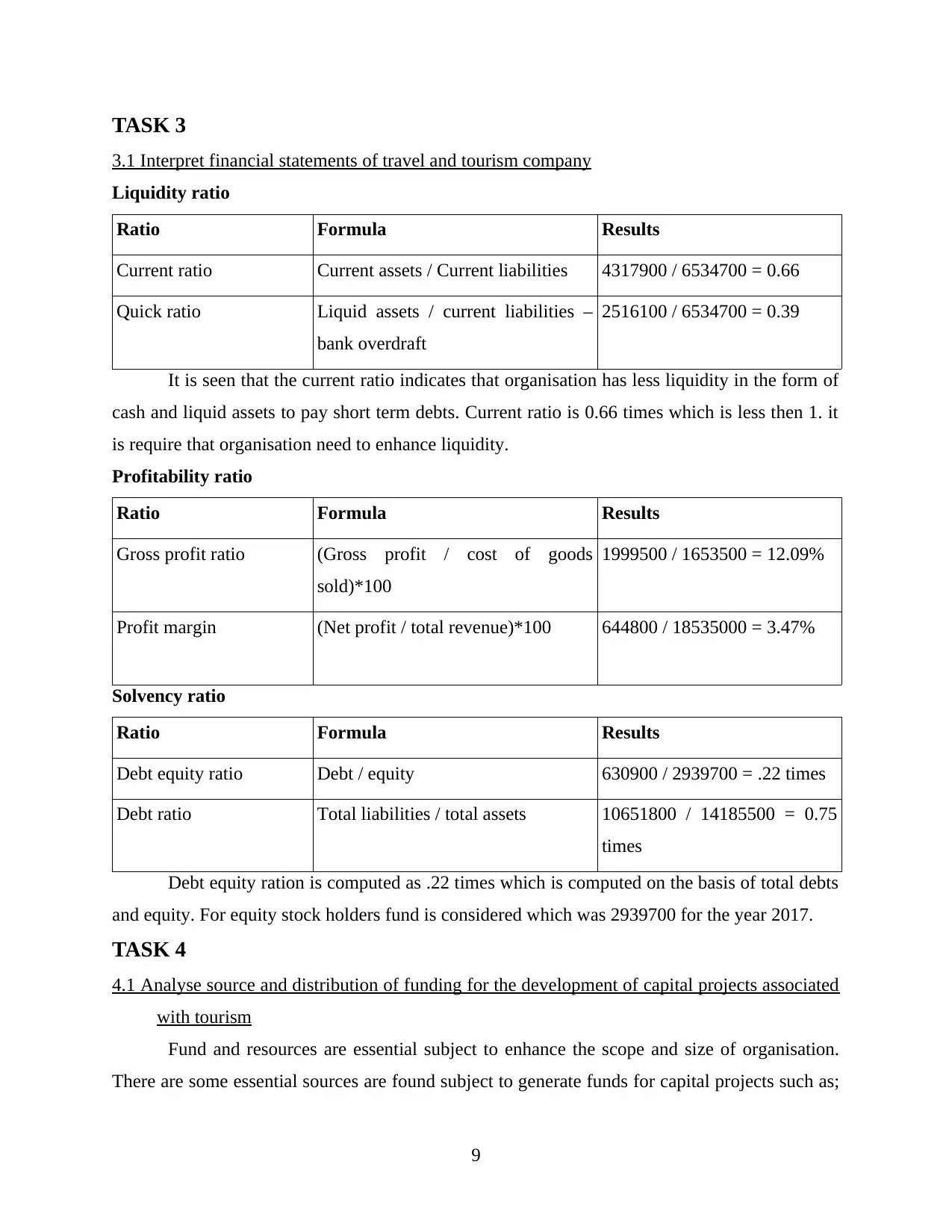
TASK 3
3.1 Interpret financial statements of travel and tourism company
Liquidity ratio
Ratio Formula Results
Current ratio Current assets / Current liabilities 4317900 / 6534700 = 0.66
Quick ratio Liquid assets / current liabilities –
bank overdraft
2516100 / 6534700 = 0.39
It is seen that the current ratio indicates that organisation has less liquidity in the form of
cash and liquid assets to pay short term debts. Current ratio is 0.66 times which is less then 1. it
is require that organisation need to enhance liquidity.
Profitability ratio
Ratio Formula Results
Gross profit ratio (Gross profit / cost of goods
sold)*100
1999500 / 1653500 = 12.09%
Profit margin (Net profit / total revenue)*100 644800 / 18535000 = 3.47%
Solvency ratio
Ratio Formula Results
Debt equity ratio Debt / equity 630900 / 2939700 = .22 times
Debt ratio Total liabilities / total assets 10651800 / 14185500 = 0.75
times
Debt equity ration is computed as .22 times which is computed on the basis of total debts
and equity. For equity stock holders fund is considered which was 2939700 for the year 2017.
TASK 4
4.1 Analyse source and distribution of funding for the development of capital projects associated
with tourism
Fund and resources are essential subject to enhance the scope and size of organisation.
There are some essential sources are found subject to generate funds for capital projects such as;
9
3.1 Interpret financial statements of travel and tourism company
Liquidity ratio
Ratio Formula Results
Current ratio Current assets / Current liabilities 4317900 / 6534700 = 0.66
Quick ratio Liquid assets / current liabilities –
bank overdraft
2516100 / 6534700 = 0.39
It is seen that the current ratio indicates that organisation has less liquidity in the form of
cash and liquid assets to pay short term debts. Current ratio is 0.66 times which is less then 1. it
is require that organisation need to enhance liquidity.
Profitability ratio
Ratio Formula Results
Gross profit ratio (Gross profit / cost of goods
sold)*100
1999500 / 1653500 = 12.09%
Profit margin (Net profit / total revenue)*100 644800 / 18535000 = 3.47%
Solvency ratio
Ratio Formula Results
Debt equity ratio Debt / equity 630900 / 2939700 = .22 times
Debt ratio Total liabilities / total assets 10651800 / 14185500 = 0.75
times
Debt equity ration is computed as .22 times which is computed on the basis of total debts
and equity. For equity stock holders fund is considered which was 2939700 for the year 2017.
TASK 4
4.1 Analyse source and distribution of funding for the development of capital projects associated
with tourism
Fund and resources are essential subject to enhance the scope and size of organisation.
There are some essential sources are found subject to generate funds for capital projects such as;
9
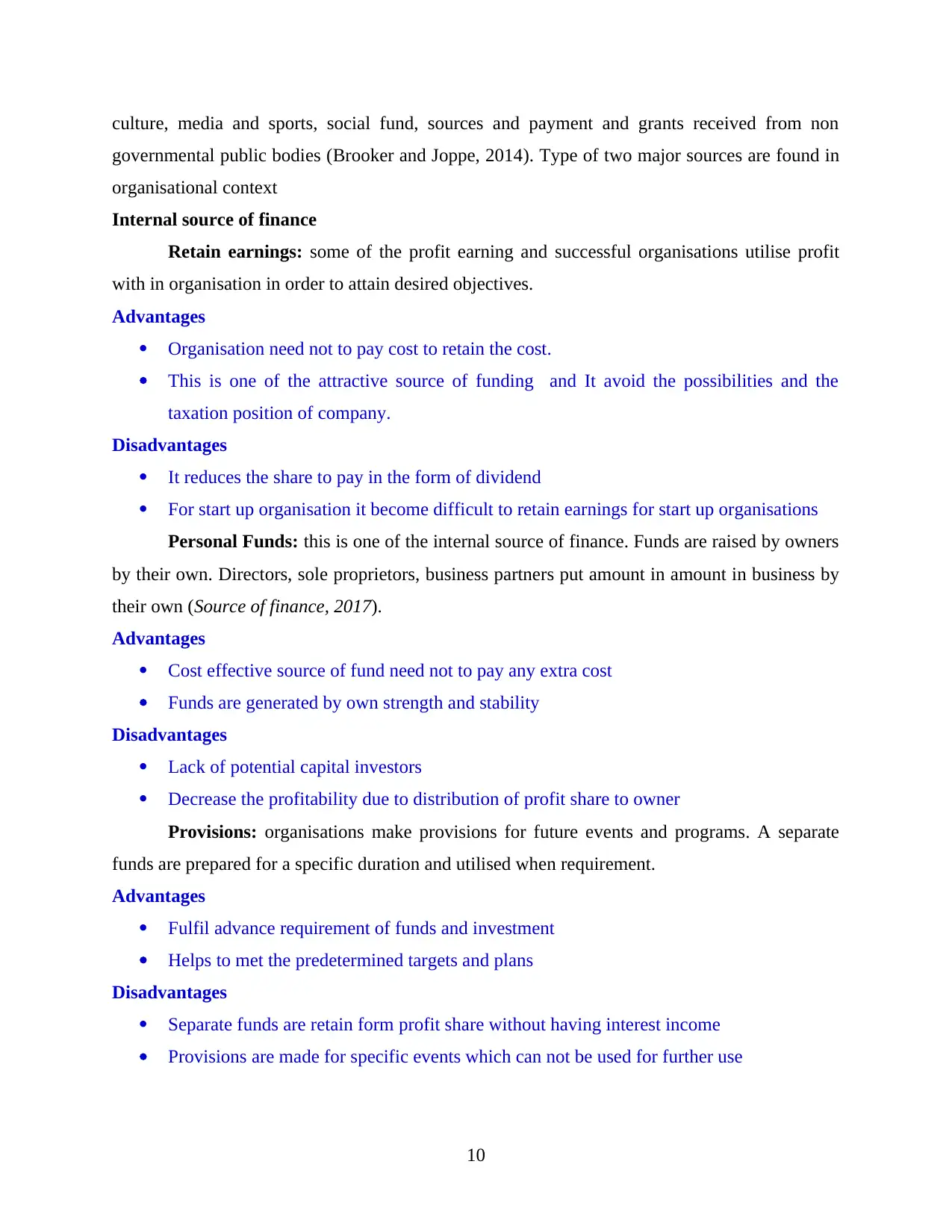
culture, media and sports, social fund, sources and payment and grants received from non
governmental public bodies (Brooker and Joppe, 2014). Type of two major sources are found in
organisational context
Internal source of finance
Retain earnings: some of the profit earning and successful organisations utilise profit
with in organisation in order to attain desired objectives.
Advantages
Organisation need not to pay cost to retain the cost.
This is one of the attractive source of funding and It avoid the possibilities and the
taxation position of company.
Disadvantages
It reduces the share to pay in the form of dividend
For start up organisation it become difficult to retain earnings for start up organisations
Personal Funds: this is one of the internal source of finance. Funds are raised by owners
by their own. Directors, sole proprietors, business partners put amount in amount in business by
their own (Source of finance, 2017).
Advantages
Cost effective source of fund need not to pay any extra cost
Funds are generated by own strength and stability
Disadvantages
Lack of potential capital investors
Decrease the profitability due to distribution of profit share to owner
Provisions: organisations make provisions for future events and programs. A separate
funds are prepared for a specific duration and utilised when requirement.
Advantages
Fulfil advance requirement of funds and investment
Helps to met the predetermined targets and plans
Disadvantages
Separate funds are retain form profit share without having interest income
Provisions are made for specific events which can not be used for further use
10
governmental public bodies (Brooker and Joppe, 2014). Type of two major sources are found in
organisational context
Internal source of finance
Retain earnings: some of the profit earning and successful organisations utilise profit
with in organisation in order to attain desired objectives.
Advantages
Organisation need not to pay cost to retain the cost.
This is one of the attractive source of funding and It avoid the possibilities and the
taxation position of company.
Disadvantages
It reduces the share to pay in the form of dividend
For start up organisation it become difficult to retain earnings for start up organisations
Personal Funds: this is one of the internal source of finance. Funds are raised by owners
by their own. Directors, sole proprietors, business partners put amount in amount in business by
their own (Source of finance, 2017).
Advantages
Cost effective source of fund need not to pay any extra cost
Funds are generated by own strength and stability
Disadvantages
Lack of potential capital investors
Decrease the profitability due to distribution of profit share to owner
Provisions: organisations make provisions for future events and programs. A separate
funds are prepared for a specific duration and utilised when requirement.
Advantages
Fulfil advance requirement of funds and investment
Helps to met the predetermined targets and plans
Disadvantages
Separate funds are retain form profit share without having interest income
Provisions are made for specific events which can not be used for further use
10
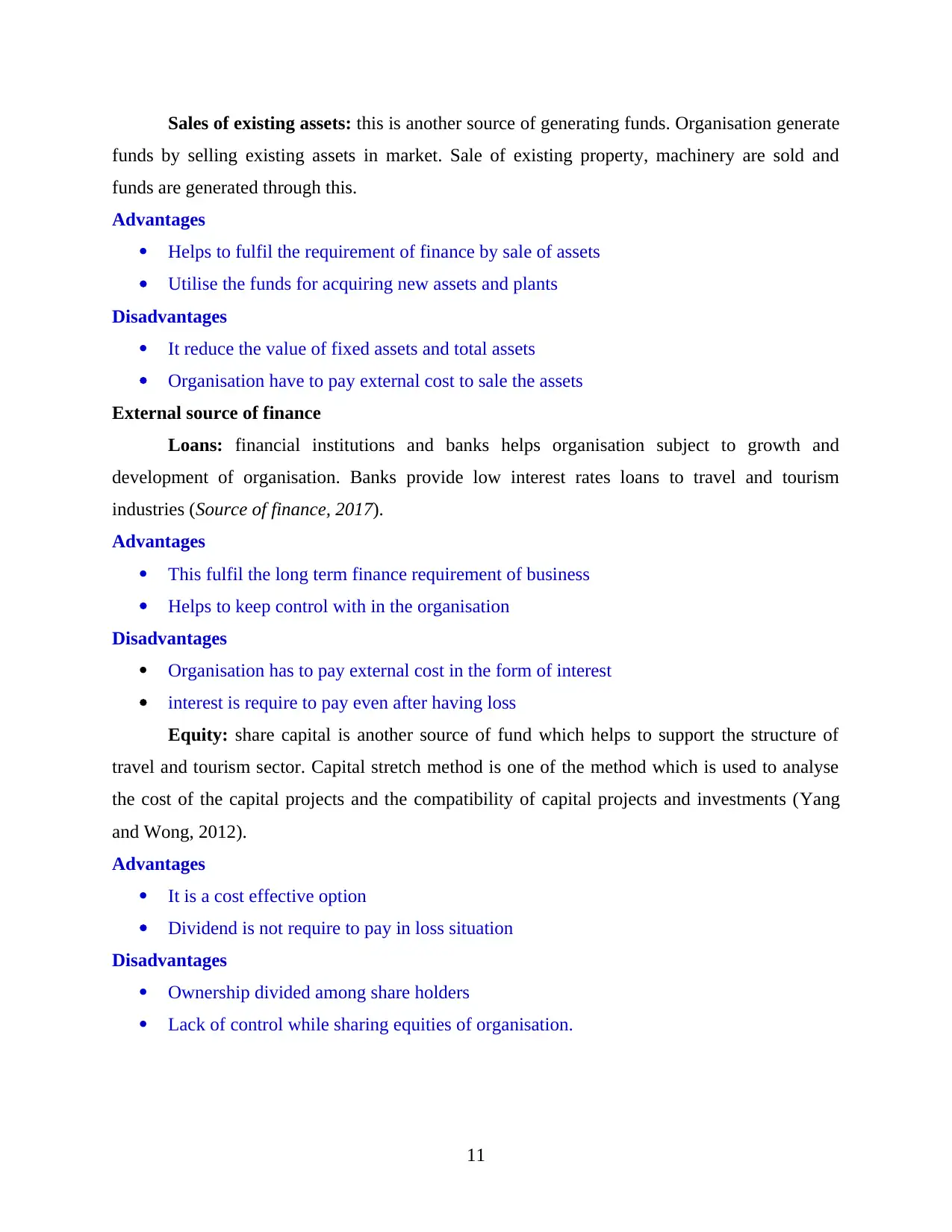
Sales of existing assets: this is another source of generating funds. Organisation generate
funds by selling existing assets in market. Sale of existing property, machinery are sold and
funds are generated through this.
Advantages
Helps to fulfil the requirement of finance by sale of assets
Utilise the funds for acquiring new assets and plants
Disadvantages
It reduce the value of fixed assets and total assets
Organisation have to pay external cost to sale the assets
External source of finance
Loans: financial institutions and banks helps organisation subject to growth and
development of organisation. Banks provide low interest rates loans to travel and tourism
industries (Source of finance, 2017).
Advantages
This fulfil the long term finance requirement of business
Helps to keep control with in the organisation
Disadvantages
Organisation has to pay external cost in the form of interest
interest is require to pay even after having loss
Equity: share capital is another source of fund which helps to support the structure of
travel and tourism sector. Capital stretch method is one of the method which is used to analyse
the cost of the capital projects and the compatibility of capital projects and investments (Yang
and Wong, 2012).
Advantages
It is a cost effective option
Dividend is not require to pay in loss situation
Disadvantages
Ownership divided among share holders
Lack of control while sharing equities of organisation.
11
funds by selling existing assets in market. Sale of existing property, machinery are sold and
funds are generated through this.
Advantages
Helps to fulfil the requirement of finance by sale of assets
Utilise the funds for acquiring new assets and plants
Disadvantages
It reduce the value of fixed assets and total assets
Organisation have to pay external cost to sale the assets
External source of finance
Loans: financial institutions and banks helps organisation subject to growth and
development of organisation. Banks provide low interest rates loans to travel and tourism
industries (Source of finance, 2017).
Advantages
This fulfil the long term finance requirement of business
Helps to keep control with in the organisation
Disadvantages
Organisation has to pay external cost in the form of interest
interest is require to pay even after having loss
Equity: share capital is another source of fund which helps to support the structure of
travel and tourism sector. Capital stretch method is one of the method which is used to analyse
the cost of the capital projects and the compatibility of capital projects and investments (Yang
and Wong, 2012).
Advantages
It is a cost effective option
Dividend is not require to pay in loss situation
Disadvantages
Ownership divided among share holders
Lack of control while sharing equities of organisation.
11
Paraphrase This Document
Need a fresh take? Get an instant paraphrase of this document with our AI Paraphraser
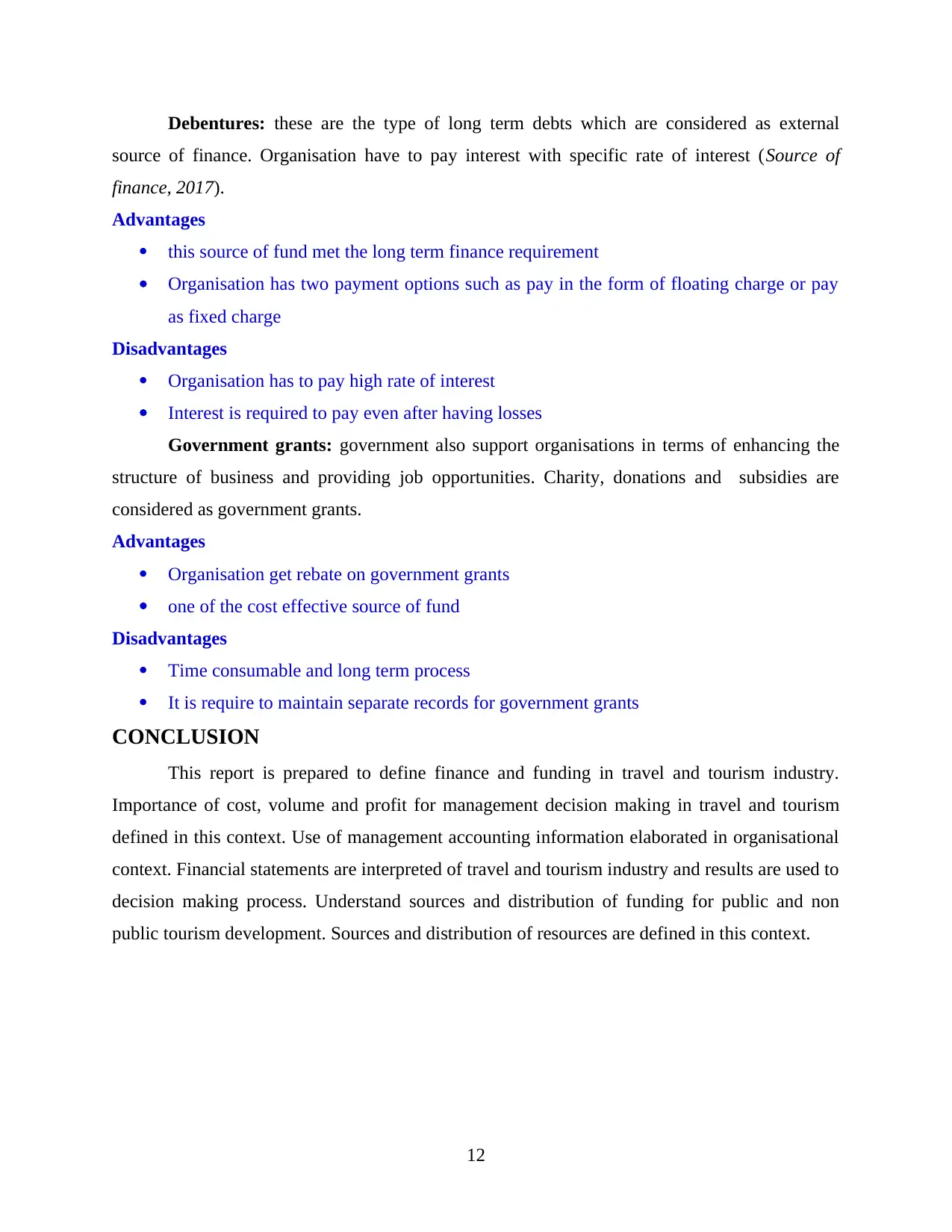
Debentures: these are the type of long term debts which are considered as external
source of finance. Organisation have to pay interest with specific rate of interest (Source of
finance, 2017).
Advantages
this source of fund met the long term finance requirement
Organisation has two payment options such as pay in the form of floating charge or pay
as fixed charge
Disadvantages
Organisation has to pay high rate of interest
Interest is required to pay even after having losses
Government grants: government also support organisations in terms of enhancing the
structure of business and providing job opportunities. Charity, donations and subsidies are
considered as government grants.
Advantages
Organisation get rebate on government grants
one of the cost effective source of fund
Disadvantages
Time consumable and long term process
It is require to maintain separate records for government grants
CONCLUSION
This report is prepared to define finance and funding in travel and tourism industry.
Importance of cost, volume and profit for management decision making in travel and tourism
defined in this context. Use of management accounting information elaborated in organisational
context. Financial statements are interpreted of travel and tourism industry and results are used to
decision making process. Understand sources and distribution of funding for public and non
public tourism development. Sources and distribution of resources are defined in this context.
12
source of finance. Organisation have to pay interest with specific rate of interest (Source of
finance, 2017).
Advantages
this source of fund met the long term finance requirement
Organisation has two payment options such as pay in the form of floating charge or pay
as fixed charge
Disadvantages
Organisation has to pay high rate of interest
Interest is required to pay even after having losses
Government grants: government also support organisations in terms of enhancing the
structure of business and providing job opportunities. Charity, donations and subsidies are
considered as government grants.
Advantages
Organisation get rebate on government grants
one of the cost effective source of fund
Disadvantages
Time consumable and long term process
It is require to maintain separate records for government grants
CONCLUSION
This report is prepared to define finance and funding in travel and tourism industry.
Importance of cost, volume and profit for management decision making in travel and tourism
defined in this context. Use of management accounting information elaborated in organisational
context. Financial statements are interpreted of travel and tourism industry and results are used to
decision making process. Understand sources and distribution of funding for public and non
public tourism development. Sources and distribution of resources are defined in this context.
12
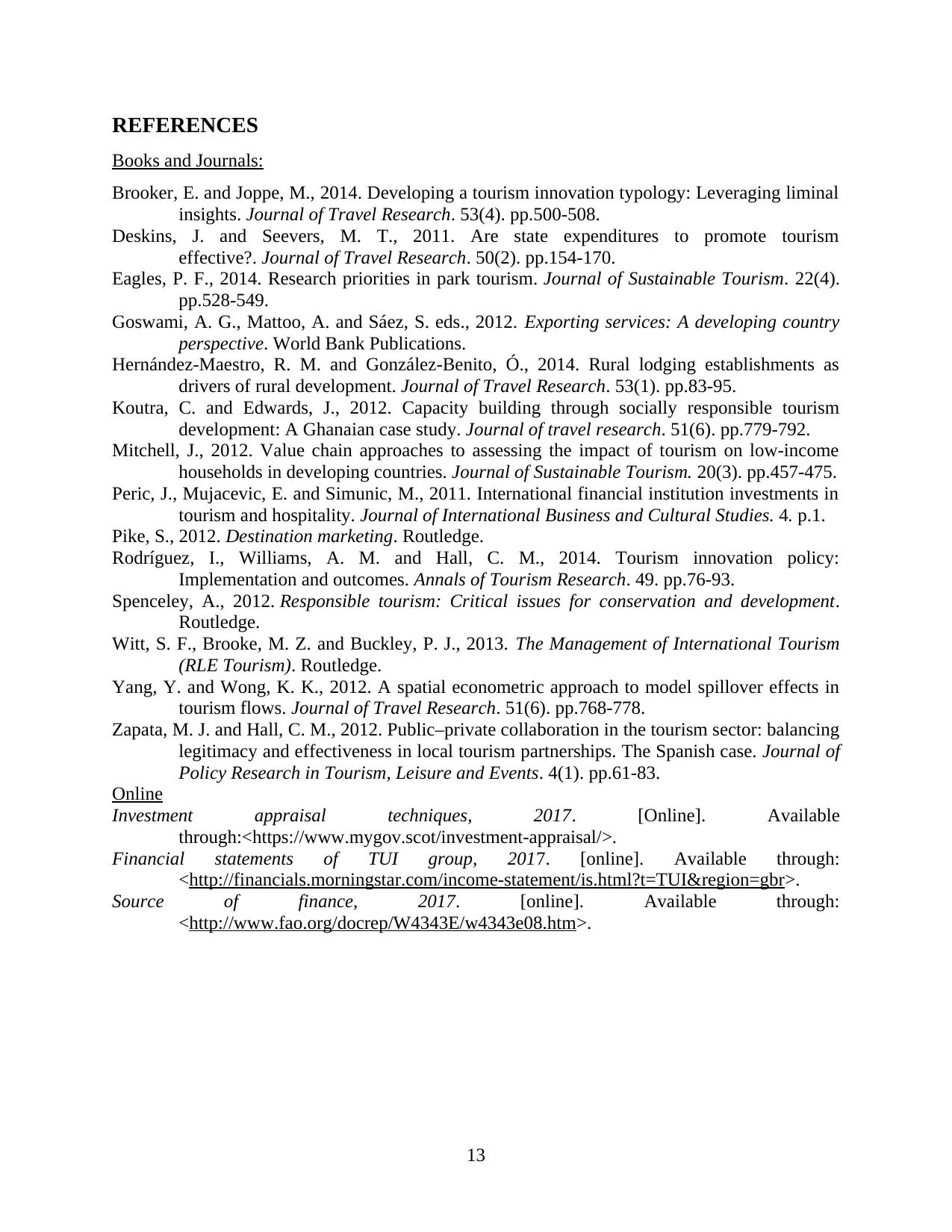
REFERENCES
Books and Journals:
Brooker, E. and Joppe, M., 2014. Developing a tourism innovation typology: Leveraging liminal
insights. Journal of Travel Research. 53(4). pp.500-508.
Deskins, J. and Seevers, M. T., 2011. Are state expenditures to promote tourism
effective?. Journal of Travel Research. 50(2). pp.154-170.
Eagles, P. F., 2014. Research priorities in park tourism. Journal of Sustainable Tourism. 22(4).
pp.528-549.
Goswami, A. G., Mattoo, A. and Sáez, S. eds., 2012. Exporting services: A developing country
perspective. World Bank Publications.
Hernández-Maestro, R. M. and González-Benito, Ó., 2014. Rural lodging establishments as
drivers of rural development. Journal of Travel Research. 53(1). pp.83-95.
Koutra, C. and Edwards, J., 2012. Capacity building through socially responsible tourism
development: A Ghanaian case study. Journal of travel research. 51(6). pp.779-792.
Mitchell, J., 2012. Value chain approaches to assessing the impact of tourism on low-income
households in developing countries. Journal of Sustainable Tourism. 20(3). pp.457-475.
Peric, J., Mujacevic, E. and Simunic, M., 2011. International financial institution investments in
tourism and hospitality. Journal of International Business and Cultural Studies. 4. p.1.
Pike, S., 2012. Destination marketing. Routledge.
Rodríguez, I., Williams, A. M. and Hall, C. M., 2014. Tourism innovation policy:
Implementation and outcomes. Annals of Tourism Research. 49. pp.76-93.
Spenceley, A., 2012. Responsible tourism: Critical issues for conservation and development.
Routledge.
Witt, S. F., Brooke, M. Z. and Buckley, P. J., 2013. The Management of International Tourism
(RLE Tourism). Routledge.
Yang, Y. and Wong, K. K., 2012. A spatial econometric approach to model spillover effects in
tourism flows. Journal of Travel Research. 51(6). pp.768-778.
Zapata, M. J. and Hall, C. M., 2012. Public–private collaboration in the tourism sector: balancing
legitimacy and effectiveness in local tourism partnerships. The Spanish case. Journal of
Policy Research in Tourism, Leisure and Events. 4(1). pp.61-83.
Online
Investment appraisal techniques, 2017. [Online]. Available
through:<https://www.mygov.scot/investment-appraisal/>.
Financial statements of TUI group, 2017. [online]. Available through:
<http://financials.morningstar.com/income-statement/is.html?t=TUI®ion=gbr>.
Source of finance, 2017. [online]. Available through:
<http://www.fao.org/docrep/W4343E/w4343e08.htm>.
13
Books and Journals:
Brooker, E. and Joppe, M., 2014. Developing a tourism innovation typology: Leveraging liminal
insights. Journal of Travel Research. 53(4). pp.500-508.
Deskins, J. and Seevers, M. T., 2011. Are state expenditures to promote tourism
effective?. Journal of Travel Research. 50(2). pp.154-170.
Eagles, P. F., 2014. Research priorities in park tourism. Journal of Sustainable Tourism. 22(4).
pp.528-549.
Goswami, A. G., Mattoo, A. and Sáez, S. eds., 2012. Exporting services: A developing country
perspective. World Bank Publications.
Hernández-Maestro, R. M. and González-Benito, Ó., 2014. Rural lodging establishments as
drivers of rural development. Journal of Travel Research. 53(1). pp.83-95.
Koutra, C. and Edwards, J., 2012. Capacity building through socially responsible tourism
development: A Ghanaian case study. Journal of travel research. 51(6). pp.779-792.
Mitchell, J., 2012. Value chain approaches to assessing the impact of tourism on low-income
households in developing countries. Journal of Sustainable Tourism. 20(3). pp.457-475.
Peric, J., Mujacevic, E. and Simunic, M., 2011. International financial institution investments in
tourism and hospitality. Journal of International Business and Cultural Studies. 4. p.1.
Pike, S., 2012. Destination marketing. Routledge.
Rodríguez, I., Williams, A. M. and Hall, C. M., 2014. Tourism innovation policy:
Implementation and outcomes. Annals of Tourism Research. 49. pp.76-93.
Spenceley, A., 2012. Responsible tourism: Critical issues for conservation and development.
Routledge.
Witt, S. F., Brooke, M. Z. and Buckley, P. J., 2013. The Management of International Tourism
(RLE Tourism). Routledge.
Yang, Y. and Wong, K. K., 2012. A spatial econometric approach to model spillover effects in
tourism flows. Journal of Travel Research. 51(6). pp.768-778.
Zapata, M. J. and Hall, C. M., 2012. Public–private collaboration in the tourism sector: balancing
legitimacy and effectiveness in local tourism partnerships. The Spanish case. Journal of
Policy Research in Tourism, Leisure and Events. 4(1). pp.61-83.
Online
Investment appraisal techniques, 2017. [Online]. Available
through:<https://www.mygov.scot/investment-appraisal/>.
Financial statements of TUI group, 2017. [online]. Available through:
<http://financials.morningstar.com/income-statement/is.html?t=TUI®ion=gbr>.
Source of finance, 2017. [online]. Available through:
<http://www.fao.org/docrep/W4343E/w4343e08.htm>.
13
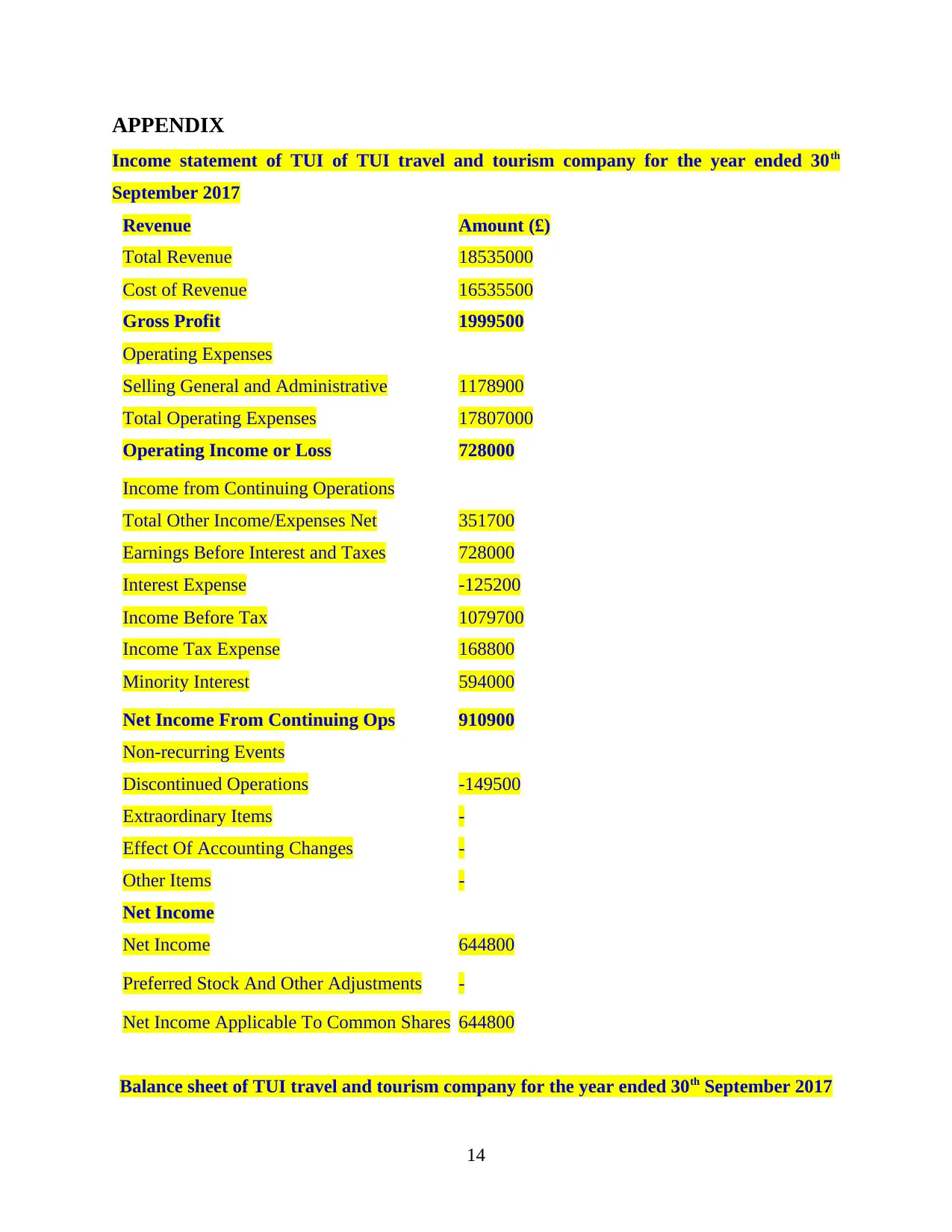
APPENDIX
Income statement of TUI of TUI travel and tourism company for the year ended 30th
September 2017
Revenue Amount (£)
Total Revenue 18535000
Cost of Revenue 16535500
Gross Profit 1999500
Operating Expenses
Selling General and Administrative 1178900
Total Operating Expenses 17807000
Operating Income or Loss 728000
Income from Continuing Operations
Total Other Income/Expenses Net 351700
Earnings Before Interest and Taxes 728000
Interest Expense -125200
Income Before Tax 1079700
Income Tax Expense 168800
Minority Interest 594000
Net Income From Continuing Ops 910900
Non-recurring Events
Discontinued Operations -149500
Extraordinary Items -
Effect Of Accounting Changes -
Other Items -
Net Income
Net Income 644800
Preferred Stock And Other Adjustments -
Net Income Applicable To Common Shares 644800
Balance sheet of TUI travel and tourism company for the year ended 30th September 2017
14
Income statement of TUI of TUI travel and tourism company for the year ended 30th
September 2017
Revenue Amount (£)
Total Revenue 18535000
Cost of Revenue 16535500
Gross Profit 1999500
Operating Expenses
Selling General and Administrative 1178900
Total Operating Expenses 17807000
Operating Income or Loss 728000
Income from Continuing Operations
Total Other Income/Expenses Net 351700
Earnings Before Interest and Taxes 728000
Interest Expense -125200
Income Before Tax 1079700
Income Tax Expense 168800
Minority Interest 594000
Net Income From Continuing Ops 910900
Non-recurring Events
Discontinued Operations -149500
Extraordinary Items -
Effect Of Accounting Changes -
Other Items -
Net Income
Net Income 644800
Preferred Stock And Other Adjustments -
Net Income Applicable To Common Shares 644800
Balance sheet of TUI travel and tourism company for the year ended 30th September 2017
14
Secure Best Marks with AI Grader
Need help grading? Try our AI Grader for instant feedback on your assignments.
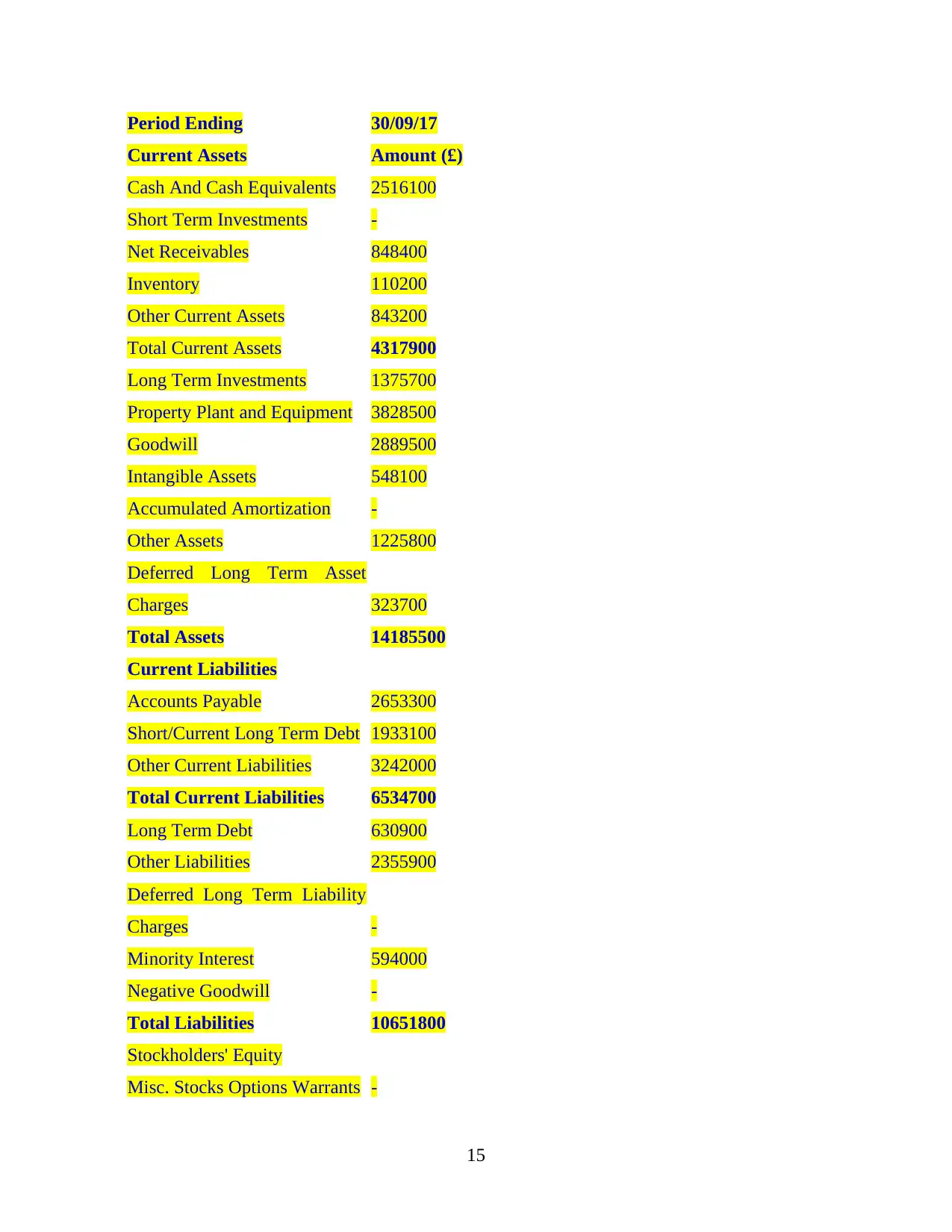
Period Ending 30/09/17
Current Assets Amount (£)
Cash And Cash Equivalents 2516100
Short Term Investments -
Net Receivables 848400
Inventory 110200
Other Current Assets 843200
Total Current Assets 4317900
Long Term Investments 1375700
Property Plant and Equipment 3828500
Goodwill 2889500
Intangible Assets 548100
Accumulated Amortization -
Other Assets 1225800
Deferred Long Term Asset
Charges 323700
Total Assets 14185500
Current Liabilities
Accounts Payable 2653300
Short/Current Long Term Debt 1933100
Other Current Liabilities 3242000
Total Current Liabilities 6534700
Long Term Debt 630900
Other Liabilities 2355900
Deferred Long Term Liability
Charges -
Minority Interest 594000
Negative Goodwill -
Total Liabilities 10651800
Stockholders' Equity
Misc. Stocks Options Warrants -
15
Current Assets Amount (£)
Cash And Cash Equivalents 2516100
Short Term Investments -
Net Receivables 848400
Inventory 110200
Other Current Assets 843200
Total Current Assets 4317900
Long Term Investments 1375700
Property Plant and Equipment 3828500
Goodwill 2889500
Intangible Assets 548100
Accumulated Amortization -
Other Assets 1225800
Deferred Long Term Asset
Charges 323700
Total Assets 14185500
Current Liabilities
Accounts Payable 2653300
Short/Current Long Term Debt 1933100
Other Current Liabilities 3242000
Total Current Liabilities 6534700
Long Term Debt 630900
Other Liabilities 2355900
Deferred Long Term Liability
Charges -
Minority Interest 594000
Negative Goodwill -
Total Liabilities 10651800
Stockholders' Equity
Misc. Stocks Options Warrants -
15
1 out of 17
Related Documents
Your All-in-One AI-Powered Toolkit for Academic Success.
+13062052269
info@desklib.com
Available 24*7 on WhatsApp / Email
![[object Object]](/_next/static/media/star-bottom.7253800d.svg)
Unlock your academic potential
© 2024 | Zucol Services PVT LTD | All rights reserved.
![[SOLVED] Strategic Planning and Resource Allocation in Tourism Industry](/_next/image/?url=https%3A%2F%2Fdesklib.com%2Fmedia%2Fimages%2Fwu%2F7146784de6384b8899876958a990bbbf.jpg&w=256&q=75)




